|

Introduction
Every now and then, a new screen comes along which
really excites us. Something new to test, or an interesting new technology or
feature always keeps us interested when it comes to reviewing monitors. The Acer
Predator
XB270HU is one of those screens which really grabs our interest! It offers
various World's first claims. It's the first 144Hz high refresh rate compatible
IPS-type panel, offering something users have been wishing for. It is the first
IPS panel to be paired with NVIDIA's G-sync dynamic refresh rate and ULMB (Ultra
Low Motion Blur) technologies. This in itself represents the first time an IPS
panel has been provided with a blur reduction mode. Early hype for this screen
has been huge since it was
announced in January 2015 for CES that it would be the first 144Hz IPS
screen on the market. It's not expected to be widely available until mid-April,
but we are fortunate to have the first available final sample
of this screen with us for an exclusive first review. We know you're all dying
to know if this is the ultimate gaming screen, as are we!
If you appreciate the review
and enjoy reading and like our work, we would welcome a
donation
to the site to help us continue to make quality and detailed reviews for you. We
worked overtime to bring you this review nice and quickly as we know how excited
people were to see how this screen performs.
|
Check Pricing and Buy - Direct Links
|
|
Amazon USA |
Amazon UK |
Overclockers UK |
Amazon GER |
Amazon CAN
|
|
TFTCentral is a participant
in the Amazon Services LLC Associates Programme, an affiliate
advertising programme designed to provide a means for sites to earn
advertising fees by advertising and linking to Amazon.com, Amazon.co.uk,
Amazon.de, Amazon.ca and other Amazon stores worldwide. We also
participate in a similar scheme for Overclockers.co.uk. |

Specifications and Features
The following table gives detailed information
about the specs of the screen:
|
Monitor
Specifications |
|
Size |
27"WS (69 cm) |
Panel Coating |
Light AG coating |
|
Aspect Ratio |
16:9 |
Interfaces |
1x DisplayPort
(version 1.2)
|
|
Resolution |
2560 x 1440 |
|
Pixel Pitch |
0.233 mm |
Design
colour |
Glossy black bezel and stand, some red trim on
base |
|
Response Time |
4ms G2G |
Ergonomics |
Tilt, 150mm height, swivel and rotate |
|
Static Contrast Ratio |
1000:1 |
|
Dynamic Contrast Ratio |
n/a |
VESA Compatible |
Yes 100mm |
|
Brightness |
350 cd/m2 |
Accessories |
Power, DisplayPort, USB cables |
|
Viewing Angles |
178 / 178 |
|
Panel Technology |
AU Optronics AHVA (IPS-type) |
Weight |
net: 7.0Kg |
|
Backlight Technology |
W-LED |
Physical Dimensions |
(WxHxD)
624 x 401 - 511 x 245mm |
|
Colour Depth |
16.78m (8-bit) |
|
Refresh Rate |
144Hz |
Special
Features |
4x
USB 3.0 ports (1 with charging capability), ULMB, G-sync |
|
Colour Gamut |
Standard gamut
~sRGB, ~72% NTSC |
The XB270HU offers a limited range of connectivity
options with only DisplayPort provided. This is for good reason though as it is
the only interface supported for the high bandwidth needed to drive the 2560 x
1440 resolution at up to 144Hz, and also allowing support for NVIDIA G-sync
technology. The DisplayPort interface is HDCP certified for encrypted content
and the video cable is also provided in the box.
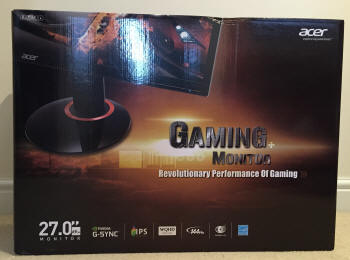
Above: Acer
XB270HU boxed up. Click for larger version
The screen has an internal power supply but comes
packaged with the power cable you need. There are also 4x USB 3.0 ports, 2
located on the bottom edge of the back section next to the video and power
connections and 2 on the left hand side of the screen. The top of the two on the
side has charging capabilities as well. There are no additional extras such as
integrated speakers, card readers, ambient light sensors or human motion sensors
provided as those are more aimed at office uses, while this is primarily a
gaming screen.
Below is a summary of the features and connections
of the screen:
|
Feature |
Yes / No |
Feature |
Yes / No |
|
Tilt adjust |
 |
DVI |
 |
|
Height adjust |
 |
HDMI |
 |
|
Swivel adjust |
 |
D-sub |
 |
|
Rotate adjust |
 |
DisplayPort |
 |
|
VESA compliant |
 |
Component |
 |
|
USB 2.0 Ports |
 |
Composite |
 |
|
USB 3.0 Ports |
 |
Audio connection |
 |
|
Card Reader |
 |
HDCP Support |
 |
|
Ambient Light Sensor |
 |
MHL Support |
 |
|
Human Motion Sensor |
 |
Integrated Speakers |
 |
|
Touch Screen |
 |
PiP / PbP |
 |
|
Factory Calibration |
 |
Blur Reduction Mode |
 |
|
Hardware calibration |
 |
G-Sync |
 |
|
Uniformity correction |
 |
FreeSync |
 |

Design and Ergonomics


Above: front views of the screen. Click for larger versions


Above: front views of the screen. Click for larger versions
The XB270HU comes in an all black design
with glossy plastics used for the bezel and base. There is an orangey-red
trim at the bottom of the stand as you can see from the photos as well.
This follows in the footsteps of the very successful and popular Asus ROG
Swift PG278Q which has a light-up red ring around the base, and the
overall design here is fairly similar. The bezel is thin and measures ~11mm
around the sides and top, and ~18.5mm along the slightly thicker bottom
edge. There is a matte silver coloured Acer logo in the middle of the
bottom bezel and an "XB270HU" model designation in the top right hand
corner.

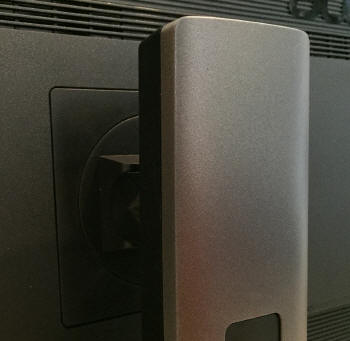
Above: rear
view of the screen. Click for larger version
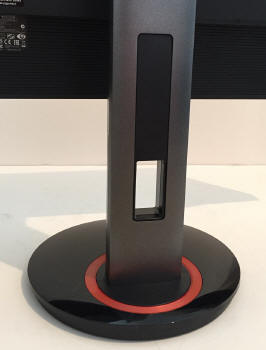
The back of the screen is finished in a
matte black plastic as shown above. There is a useful cable tidy hole in
the back of the stand. The stand is also easily detached via a button and
the screen can be VESA mounted (100 x 100mm) if required.

The base of the stand is circular in shape
and is a glossy black plastic with red circular trim. It measures ~245mm
width and provides a pretty sturdy base for the screen. There is a full
range of ergonomic adjustments offered from the stand as well which is great
to see.
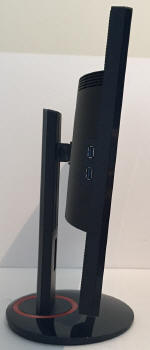
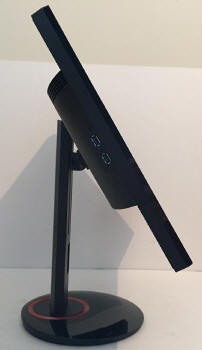
Above: full
range of tilt adjustment shown. Click for larger versions
The tilt function is smooth but a little
stiff to move, but it does offer a wide range of angles to choose from as
shown above.
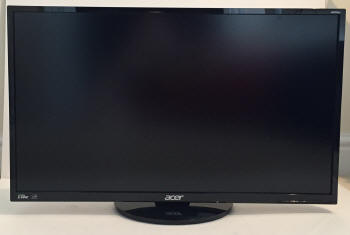
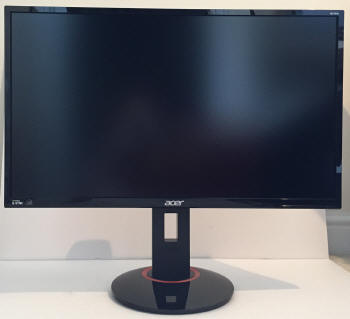
Above: full
range of height adjustment shown. Click for larger versions
Height adjustment is a easier to move and is
smooth, offering a very good range of
adjustment again. At the lowest height setting the bottom edge of the
screen is approximately 30mm from the edge of the desk. At the maximum
setting it is ~180mm, and so there is a 150 mm total adjustment range
available here.
Side to side swivel has a smooth movement
but it is very stiff to operate.

Above:
rotated view of the screen. Click for larger version
The rotate function is a stiff but quite smooth
to move if you want to switch into portrait mode. Overall when making
adjustments to your viewing angle and position the screen has some low levels
of wobble. It is fairly sturdy though during normal uses on the desk.
A summary of the screens ergonomic adjustments
is shown below:
|
Function |
Range |
Smoothness |
Ease of Use |
|
Tilt |
Yes |
Smooth |
A little stiff |
|
Height |
150mm |
Smooth |
Easy |
|
Swivel |
Yes |
Smooth |
Very stiff |
|
Rotate |
Yes |
Quite Smooth |
Stiff |
|
Overall |
Good range of adjustments and
easy enough to use overall. Good tilt and height ranges. |
The materials were of a good standard and the
build quality felt good as well. It felt more premium than some more basic
Acer office range models we had seen in the past and we were pleased. There was no audible noise from the screen,
even when conducting specific tests which can often identify buzzing issues.
The whole screen remained very cool even during prolonged use as well which
was pleasing.
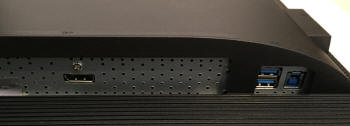
Above: rear
views of the screen showing connections.
The back of the screen provides a connection for
the power cable which is provided with the screen. There is then a single DisplayPort
video connection, USB upstream and 2x USB 3.0
downstream on the back of the screen.
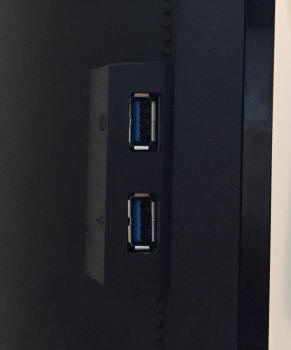
Above: side of
the screen showing additional 2x USB 3.0 connection. Click for larger version
Two additional easy-access USB port are
available on the left hand side of the screen which is nice to see. The top of
these two also has charging capabilities. You can also set in the
OSD menu
whether the charging port can function when the screen is off.

OSD Menu

Above: OSD control buttons on the bottom right hand edge
The OSD menu is accessed and controlled through a
series of 5 pressable buttons located on the front bezel in the bottom right
hand corner. They are pretty hard to see during normal screen use as they blend
nicely into the bezel of the screen. A blue power LED is located next to them
and to the right is an on/off power button. This also glows amber when the
screen is on standby. The light from the power LED does spill out a little under
the two buttons it is adjacent to, but nothing serious, just a minor build
quality quibble.
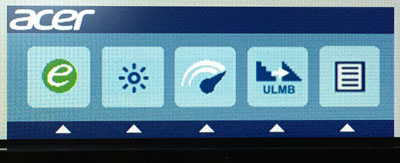
Pressing any of the buttons brings up the above
quick access menu. You have 4 quick access options available which we will show
you next. The far right option brings up the main OSD menu.

The first quick access is to the
eColor Management menu, basically a series of 5
preset modes which we will
test later on
as well.
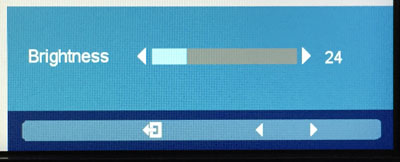
The second button gives you quick access to the brightness control slider. One
gripe is that this is very slow to move between settings, even when
holding the button for up/down. This is the same for any slider, so anything
with a lot of adjustments between 0 - 100 it is a bit cumbersome to use.
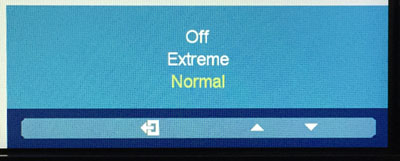
The third button gives you quick access to the overdrive (OD) option, with 3
settings available. We will again test those
later on
in the review.
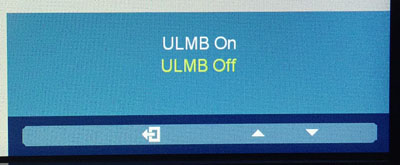
The fourth button gives you access to the
ULMB setting
with options for on or off available from the quick access menu. A further
setting is available for Pulse Width from within the main OSD menu.
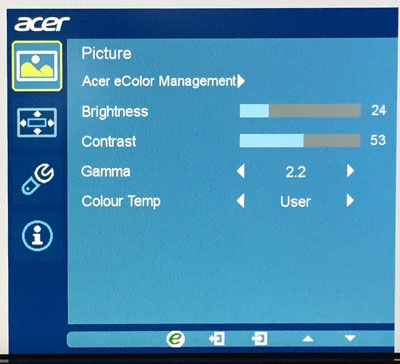
Pressing the main OSD menu button brings up the
display above. This is split in to 4 sections down the left hand side, with the
options available in each shown on the right hand side. The software was quick
to navigate and looked nice we thought. In the first 'picture' section of the
menu there are options to access the eColor preset modes, change brightness,
contrast, gamma and colour temp modes as well. Plenty to play around with for
calibration.
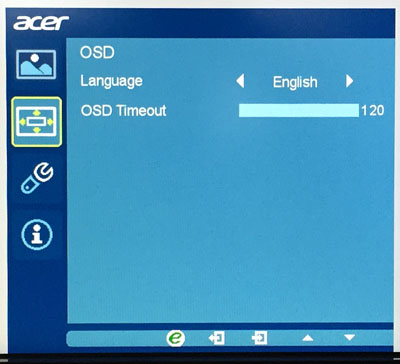
The second section just allows you to control the OSD software itself.

The 'settings' section has a few more useful features. You can change the OD
control again here if you want to, and the ULMB feature. You can also choose
whether the charging USB port will charge devices when the screen is powered
off.

The 'refresh rate bar' setting controls a thin red line shown in the bottom
left hand corner of the screen as shown above. This can either be 4 or 8 pixels wide (or off)
and shows your current refresh rate setting as varying heights of the line. It's
designed to give you a visual indication of your refresh rate when using G-sync
dynamic refresh rate control really. A nice idea, and at only a few pixels wide
it's not obtrusive.
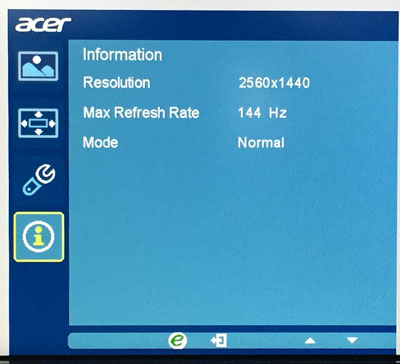
The final 'information' section just confirms your resolution, refresh rate and
OD mode.

There is a factory menu available as well which
confirms a few useful bits of information, including the panel being used here.
You can also adjust the OD setting value and RGB levels for the warm, normal and
cool preset modes. We won't mess around with those in this review but might have
a look at them later on.
All in all we liked the design and layout of the
OSD menu. There were a fair few options to play with as well which was good.
Navigation was mostly pretty easy although sometimes it was a little confusing
how far you'd drilled in to any given option. The speed of changing a setting
(e.g. brightness between 0 - 100) can be cumbersome too.

Power Consumption
In terms of power consumption the manufacturer
lists typical usage of 35.0W and 0.45W in standby. We carried out our normal tests to
establish its power consumption ourselves.
|
 |
|
State and Brightness
Setting |
Manufacturer Spec (W) |
Measured Power Usage
(W) |
|
Default (100%) |
35.0 |
44.3 |
|
Calibrated (24%) |
- |
25.8 |
|
Maximum Brightness (100%) |
- |
44.3 |
|
Minimum Brightness (0%) |
- |
19.6 |
|
Standby |
0.45 |
0.6 |
|
We tested this ourselves and found that out of the
box the screen used 44.3W at the default 100% brightness setting. Once calibrated the screen reached
25.8W consumption, and in standby it
used only 0.6W. We have plotted these results below compared with other screens
we have tested. The consumption is comparable actually to the other W-LED
backlit displays we have tested, with GB-r-LED backlit displays (e.g. Dell U2713H) using a bit more than most W-LED backlights.


Panel and Backlighting
|
Panel Manufacturer |
AU Optronics |
Colour Palette |
16.7 million |
|
Panel Technology |
AHVA (IPS-type) |
Colour Depth |
8-bit |
|
Panel Module |
M270DAN02.3 |
Colour space |
Standard gamut |
|
Backlighting Type |
W-LED |
Colour space coverage (%) |
~sRGB, ~72% NTSC |
Panel Part and Colour Depth
The Acer XB270HU features an
AU Optronics M270DAN02.3 AHVA (IPS-type) panel which is capable of producing 16.78 million colours.
The panel offers an 8-bit colour depth and
the part is confirmed when
accessing the factory OSD menu as shown below. We want to try and ensure there's
no confusion between AHVA and IPS as well at this juncture. AHVA (Advanced Hyper
Viewing Angle) is a relatively new technology developed by AU Optronics, not to
be confused with their more long-standing technology AMVA (Advanced
Multi-Domain Vertical Alignment). It is AU Optronics' answer to LG.Display's
very popular, and long-established IPS (In Plane Switching) technology. Testing
of this technology has revealed that it is for all intents and purposes the same
as IPS. Performance characteristics, features and specs are all pretty much
identical. AUO weren't allowed to simply call their technology IPS due to
trademark issues, which is why they adopted their own new name. Samsung are the
same with their PLS (Plane to Line Switching) panel tech, which is another
IPS-clone. You will see pretty much all monitor manufacturers now simply use the
term IPS, since it is so well known in the market, but underneath they may be
using an IPS version from LG.Display, AU Optronics or Samsung potentially.
People should not get concerned with the semantics here, which is why we will
continually refer to this as an "IPS-type" panel throughout the review.

Screen
Coating
The
screen coating on the XB270HU is a light anti-glare (AG) offering. It isn't a
semi-glossy coating, but it is light as seen on other modern IPS type panels. Thankfully it
isn't a heavily grainy coating like some old IPS panels feature and is also
lighter than modern TN Film panel coating, including that on the Asus ROG Swift
PG278Q screen. It retains its anti-glare properties to avoid too many
unwanted reflections of a full glossy coating, but does not produce an too
grainy or dirty an image that some thicker AG coatings can. There were some
very slight cross-hatching patterns visible on the coating if you looked very
closely, but nothing to the extent of what some people find problematic on the
U2713HM model.
Backlight Type and Colour Gamut
The screen uses a White-LED (W-LED) backlight unit
which has become very popular in today's market. This helps reduce power
consumption compared with older CCFL backlight units and brings about some
environmental benefits as well. The W-LED unit offers a standard colour gamut
which is approximately equal to the sRGB colour space.
Anyone wanting to work with wider colour spaces would need to consider wide
gamut CCFL screens or the newer range of GB-r-LED type displays available
now. If
you want to read more about colour spaces and gamut then please have a read of
our
detailed article.
Backlight
Dimming and Flicker
We tested the screen to establish the methods used
to control backlight dimming. Our in depth article talks in more details about a
common method used for this which is called
Pulse Width Modulation (PWM). This in itself gives cause for concern to some
users who have experienced eye strain, headaches and other symptoms as a result
of the flickering backlight caused by this technology. We use a photosensor +
oscilloscope system to measure backlight dimming control
with a high level of accuracy and ease. These tests allow us to establish
1) Whether PWM is being used to control the
backlight
2) The frequency and other characteristics at which this operates, if it is used
3) Whether a flicker may be introduced or potentially noticeable at certain
settings
If PWM is used for backlight dimming, the higher
the frequency, the less likely you are to see artefacts and flicker. The duty
cycle (the time for which the backlight is on) is also important and the shorter
the duty cycle, the more potential there is that you may see flicker. The other
factor which can influence flicker is the amplitude of the PWM, measuring the
difference in brightness output between the 'on' and 'off' states. Please
remember that not every user would notice a flicker from a backlight using PWM,
but it is something to be wary of. It is also a hard thing to quantify as it is
very subjective when talking about whether a user may or may not experience the
side effects.
100% 50%
0%



Above scale = 1
horizontal grid = 5ms
At 100% brightness a constant voltage is applied
to the backlight. As you reduce the brightness setting to dim the backlight a
Direct Current (DC) method is used, as opposed to any form of PWM. This applies
to all brightness settings from 100% down to 0%. The screen is flicker free as a
result.
|
Pulse Width
Modulation Used |
No |
|
Cycling
Frequency |
n/a |
|
Possible
Flicker at |
|
|
100% Brightness |
No |
|
50% Brightness |
No |
|
0% Brightness |
No |
For an up to date list of all flicker-free (PWM free) monitors please see our
Flicker Free Monitor Database.

Contrast
Stability and Brightness
We wanted to see how much variance there was in
the screens contrast as we adjusted the monitor setting for brightness.
In theory, brightness and contrast are two independent parameters, and good
contrast is a requirement regardless of the brightness adjustment.
Unfortunately, such is not always the case in practice. We recorded the
screens luminance and black depth at various OSD brightness settings, and
calculated the contrast ratio from there. Graphics card settings were left at
default with no ICC profile or calibration active. Tests were made using an
X-rite i1 Display Pro colorimeter. It should be noted that we used the
BasICColor calibration software here to record these, and so luminance at
default settings may vary a little from the LaCie Blue Eye Pro report.
|
OSD
Brightness |
Luminance
(cd/m2) |
Black
Point (cd/m2) |
Contrast
Ratio
( x:1) |
|
100 |
326.60 |
0.31 |
1054 |
|
90 |
303.58 |
0.29 |
1047 |
|
80 |
282.15 |
0.27 |
1045 |
|
70 |
259.17 |
0.25 |
1037 |
|
60 |
235.26 |
0.23 |
1023 |
|
50 |
209.91 |
0.20 |
1050 |
|
40 |
182.29 |
0.18 |
1013 |
|
30 |
153.39 |
0.15 |
1023 |
|
20 |
121.96 |
0.12 |
1016 |
|
10 |
88.78 |
0.09 |
986 |
|
0 |
52.93 |
0.05 |
1059 |
|
Total Luminance Adjustment Range
(cd/m2) |
273.67 |
Brightness OSD setting controls backlight? |
 |
|
Total Black Point
Adjustment Range (cd/m2) |
0.26 |
|
Average Static Contrast Ratio |
1032:1 |
PWM Free? |
 |
|
Recommended OSD setting
for 120 cd/m2 |
20 |
The brightness control gave us a very good range
of adjustment. At the top end the maximum luminance reached 326.6
cd/m2 which was
high, although slightly lower than the specified maximum brightness of 350 cd/m2
from the manufacturer. There was a decent 273.67 cd/m2 adjustment
range in total, and so at the minimum setting you could reach down to a low
luminance of 52.93 cd/m2. This should be more than adequate for those
wanting to work in darkened room conditions with low ambient light. A setting of
20 in the OSD menu should return you a
luminance of around 120 cd/m2 at default settings.
It should be noted that the
brightness regulation is controlled without the need for
Pulse Width Modulation, using a Direct Current (DC) method for all
brightness settings between 100 and 0% and so the screen is flicker free as
advertised.

We have plotted the
luminance trend on the graph above. The screen behaves as it should in this
regard, with a reduction in the luminance output of the screen controlled by the
reduction in the OSD brightness setting. This is not quite a linear relationship as
the brightness adjustments between settings of 50 and 0 controls a slightly steeper
luminance range than settings between 100 and 50.

The average contrast ratio of
the screen was excellent for an IPS-type panel with an average of 1032:1. This was
nice and stable across the brightness adjustment range as shown above.

Testing
Methodology
An
important thing to consider for most users is how a screen will perform out of
the box and with some basic manual adjustments. Since most users won't have
access to hardware colorimeter tools, it is important to understand how the
screen is going to perform in terms of colour accuracy for the average user.
We restored our graphics card to default settings and disabled any previously active
ICC profiles and gamma corrections. The screen was tested at default factory settings using the
DisplayPort interface, and analysed using
an
X-rite i1
Pro Spectrophotometer (not to be confused with the i1 Display Pro
colorimeter) combined with
LaCie's Blue Eye Pro software suite. An X-rite i1 Display Pro colorimeter was
also used to verify the black point and contrast ratio since the i1 Pro
spectrophotometer is less
reliable at the darker end.
Targets for these tests are as follows:
-
CIE Diagram - validates the colour space
covered by the monitors backlighting in a 2D view, with the black triangle representing the
displays gamut, and other reference colour spaces shown for comparison
-
Gamma - we aim for 2.2 which is the default
for computer monitors
-
Colour temperature / white point - we aim
for 6500k which is the temperature of daylight
-
Luminance - we aim for 120
cd/m2, which is
the recommended luminance for LCD monitors in normal lighting conditions
-
Black depth - we aim
for as low as possible to maximise shadow detail and to offer us the best
contrast ratio
-
Contrast ratio - we aim
for as high as possible. Any dynamic contrast ratio controls are turned off here
if present
-
dE average / maximum -
as low as possible.
If DeltaE >3, the color displayed is significantly different from the
theoretical one, meaning that the difference will be perceptible to the
viewer.
If DeltaE <2, LaCie considers the calibration a success; there remains a
slight difference, but it is barely undetectable.
If DeltaE < 1, the color fidelity is excellent.

Default Performance and
Setup
Default settings of the screen were as follows:
|
Monitor OSD Option |
Default Settings |
|
Preset mode (eColor mode) |
Standard |
|
Brightness |
100 |
|
Contrast |
50 |
|
Gamma |
2.2 |
|
Colour Temp |
Warm |
|
RGB |
m/a |

Acer XB270HU - Default Settings




|
|
Default Settings |
|
luminance (cd/m2) |
336 |
|
Black Point (cd/m2) |
0.32 |
|
Contrast Ratio |
1054:1 |
Initially out of the box the screen was set in the
default 'standard' eColor preset mode. Gamma mode was set at 2.2, and colour
temperature on warm. The screen was extremely bright as it was set at
a default 100% brightness setting. Colour balance and temperature felt
good although a little cool, and you could tell it was a standard gamut screen. We went ahead and measured the default state with
the i1 Pro.
The
CIE diagram on the left of the image confirms that the monitors colour gamut
(black triangle) is roughly equal to
the sRGB colour space. There is some minor over-coverage in all shades but not by anything significant.
Default gamma was recorded at 2.4 average, leaving it with a 9% deviance
from the target which was a little off. White point was measured at 6883k
being a bit too cool from the target of 6500k but with a fairly low 6%
deviance.

Luminance was recorded at a very bright 336
cd/m2 which is
too high for prolonged general use. The screen was set at a default 100%
brightness in the OSD menu but that is easy to change of course to reach a more
comfortable setting without impacting any other aspect of the setup. The black
depth was 0.32 cd/m2 at this default
brightness setting, giving us an excellent (for an IPS-type panel) static contrast ratio of
1054:1.
Colour accuracy was very good out of the box
with a default dE average of 1.9, and a maximum of only 3.0. Testing the screen with various gradients showed smooth transitions
with no sign of any banding thankfully. There was some gradation evident
as you will see from most monitors in darker tones. Overall the default setup
was reasonably good, although some corrections are needed to the gamma and white
point. There are options for both in the OSD so we will see if it's possible to
get a better default setup through some basic OSD changes.

eColor Management

We tested the eColor Management options as well
which are a range of fairly basic preset modes. The default 'standard' mode was
tested above in the
previous section.
Switching to the 'User' eColor mode made no changes to the OSD settings other
than to alter the brightness control down from 100 to 77 by default. As a
result, there was no change to the default setup other than a lower luminance of
284 cd/m2.
In the 'User' mode you can alter the brightness and other settings to your
liking.
Same thing with the 'ECO'
eColor mode which just reduced the brightness setting to a locked 44. If you
change this, you revert to the 'User' mode. At this 44 brightness setting the
ECO mode gave a luminance of 199 cd/m2. Again, the rest of the setup
remained unchanged.
Setup in Graphics eColor preset mode
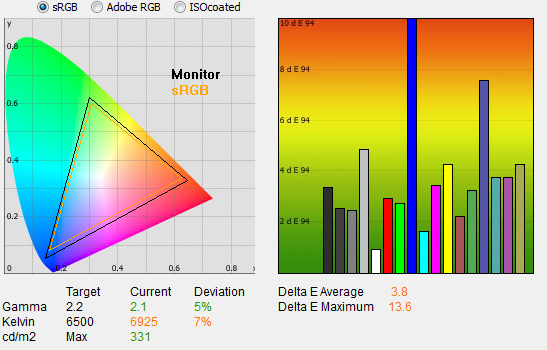
When you switch to the 'Graphics' eColor mode
the brightness is locked this time at 97, although the contrast setting has been
moved away from it's default of 50, to 60. As a result the setup is
impacted in several ways. The gamma has moved closer to the desired 2.2 level,
now showing a lower 5% deviance from the target. Colour temperature was a little
cooler than before (7% out), but the most obvious change came in the colour
accuracy. dE average had now increased to 3.8, and a maximum of 13.6. For colour
critical and graphics work you would be better settings up the 'User' mode to a
more accurate level (see following sections).
Setup in Movie eColor preset mode
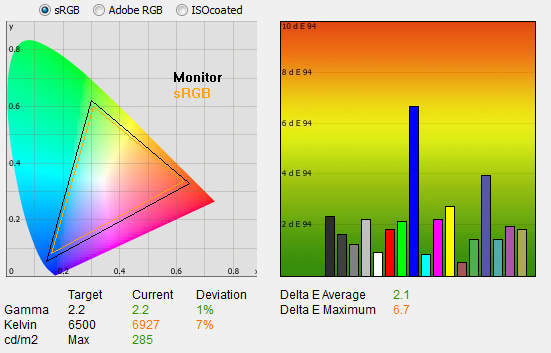
The 'Movie' eColor mode showed a better setup
though. In this mode the brightness setting is locked at 77, and contrast has
been altered to 56. Gamma at this setting was now very close to the target with
only a 1% deviance. Colour temperature remained too cool as before, but dE had
improved back down to 2.1 average. There was some fairly large error in some
colours, where dE maximum was 6.7.
The eColor modes are basically a series of
preset brightness and contrast modes where those two settings are locked in each
mode. If you change either of them you just are automatically switched to the
'user' mode. Thankfully you can alter the gamma and colour temperature mode in
each, so you could in theory set them up for different uses. It's a shame though
that you can't define your own brightness setting for each, as really they are
all too bright for comfortable prolonged use. The ECO mode (capped at 44
brightness and therefore 199
cd/m2) is
perhaps useable in certain circumstances. Most people will probably just want to
set up the 'User' mode to their liking we would think.

Gamma and Colour
Temperature

The XB270HU features a range of 3 defined 'colour temp'
modes along with a user configurable mode within the OSD menu as shown in the
above screen shots (4 modes total). There are also 4
pre-defined gamma modes available to choose from. We measured the screen
with the X-rite i1 Pro spectrophotometer in each of these modes to establish
their colour temperature / white point. We also tested the average gamma in each mode,
while colour temperature was left at the default 'warm' setting. All other settings were left at factory defaults and no
ICC profile was active. The results are recorded below:
Gamma Setting
|
Gamma Mode |
Average Gamma |
Deviance from
2.2 Gamma |
|
1.9 |
2.1 |
6% |
|
2.2 |
2.4 |
9% |
|
2.5 |
2.7 |
22% |
|
Gaming |
3.0 |
35% |
Colour Temp Setting
|
Color Temp
Mode |
Measured
White point (k) |
|
Normal |
7823 |
|
Warm |
6883 |
|
Cool |
9688 |
|
User |
6883 |
The default gamma mode of 2.2 delivered a gamma
which was a bit too high, measured at an average of 2.4 and with 9% deviance.
The 1.9 setting was a little closer (6%) deviance but now too low. The 2.5 and
gaming modes pushed the gamma average even higher still. Certainly beyond
anything we'd want to use for desktop or day to day use, but actually the
gaming mode might be useful to some people who find themselves increasing the
gamma in games.
The colour temp modes were a little off. We
would have liked to have seen the 'normal' mode close to 6500k, when in fact
the 'warm' mode was closest at 6883k, being still a little too cool. The
'normal' mode was much cooler at 7823k, and 'cool' was even more so at 9688k.
Thankfully there is a 'user' mode where you can alter the RGB levels yourself
to achieve your desired white point. By default it is the same as the 'normal'
mode incidentally.

Optimum OSD
Adjustments
Having tested the various brightness, eColor,
gamma and colour temp modes we thought it would be useful to summarise what we
would consider to be the optimum OSD adjustments out of the box, before any
calibration device is used to profile the screen. These are
designed to help you reach a more comfortable and reliable setup without the
need for a calibration tool. In the following section we will calibrate the
screen properly and provide a calibrated ICC profile for those who would like to
try it.
|
Monitor OSD Option |
Recommended Optimum Settings |
|
eColor mode |
User |
|
Brightness |
24 |
|
Contrast |
50 |
|
Gamma |
2.2 |
|
Colour Temp |
User |
|
RGB |
50, 45, 46 |

Acer XB270HU - Optimum OSD settings
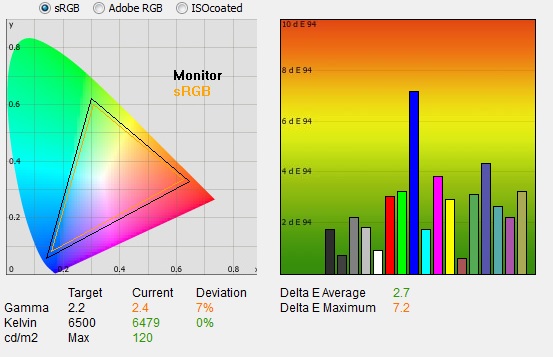
|
|
Optimum OSD Settings |
|
luminance (cd/m2) |
120 |
|
Black Point (cd/m2) |
0.13 |
|
Contrast Ratio |
936:1 |
We changed to the 'user' eColor mode which allowed
us to make alterations to all of the OSD settings. Gamma we stuck with 2.2 as it
looked better to the naked eye and made it easier to obtain a reliable white
point through the adjustment of the RGB levels. For this we had to change to the
'user' color temp mode, which then gave us access to the RGB controls. Through
those adjustments we managed to achieve a better white point at 6479k (0%
deviance) basically spot on to the 6500k target. An adjustment to the brightness
setting achieved a far more comfortable luminance and we still maintained a nice
high contrast ratio of 936:1. The reason for the slight drop in contrast ratio
is the adjustment to the RGB channels to correct the white point. The gamma curve was still a little off from the
target, measured at 2.4 average (7% out) but the rest of the setup was pretty
good. Colour accuracy remained decent with dE average of 2.7, although some
higher errors where dE reached up to 7.2 were detected. These settings do
represent a decent setup for your average user though and it's very easy to
achieve these results through just some simple OSD changes as we've shown.

Calibration
We used the
X-rite i1 Pro spectrophotometer combined with the LaCie Blue Eye Pro
software package to achieve these results and reports. An X-rite i1 Display Pro
colorimeter was used to validate the black depth and contrast
ratios due to lower end limitations of the i1 Pro device.
|
Monitor OSD Option |
Calibrated Settings |
|
eColor mode |
User |
|
Brightness |
24 |
|
Contrast |
50 |
|
Gamma |
2.2 |
|
Colour Temp |
User |
|
RGB |
50, 45, 46 |

Acer XB270HU - Calibrated Settings

|
|
Calibrated Settings |
|
luminance (cd/m2) |
121 |
|
Black Point (cd/m2) |
0.12 |
|
Contrast Ratio |
1000:1 |
We stuck with the 'user' preset mode first
of all which would give us access
to the RGB channels, as well as the brightness and contrast settings which are
available in all the modes. All these OSD
changes allowed us to obtain an
optimum hardware starting point and setup before software level changes would be
made at the graphics card level. We left the LaCie software to calibrate
to "max" brightness which would just retain the luminance of whatever brightness
we'd set the screen to, and would not in any way try and alter the luminance at
the graphics card level, which can reduce contrast ratio. These adjustments
before profiling the screen would help preserve tonal values and limit
banding issues. After this we let the software carry out the LUT adjustments and create an
ICC profile.

Average gamma was now corrected to 2.2 average,
correcting the 7 - 9% deviance we'd seen out of the box, depending on the OSD
settings used. The
white point had already been corrected nicely in the previous section through
adjustments
to the OSD RGB levels. It was maintained at an accurate level, measured at 6522k
(0% deviance). Luminance had been improved thanks to the adjustment to the
brightness control and was now being measured at 121
cd/m2. This
left us a black depth of 0.12 cd/m2 and maintained an excellent static contrast ratio
(for an IPS-type panel) of
1000:1 - spot on to the spec in fact! Colour accuracy of the resulting
profile was excellent, with dE average of 0.4 and maximum of 1.0. LaCie would
consider colour fidelity to be very good overall.
Testing the screen with various colour gradients
showed mostly smooth transitions. There was some slight gradation in darker tones
but no banding introduced due to the adjustments to the
graphics card LUT from the profilation of the screen which was pleasing.
You can use our settings and
try our calibrated ICC profile if you wish, which are available in
our ICC profile database. Keep in mind that results will vary from one
screen to another and from one computer / graphics card to another.

Calibration Performance Comparisons

The comparisons made in this section try to give
you a better view of how each screen performs, particularly out of the box which
is what is going to matter to most consumers. When comparing the default factory
settings for each monitor it is important to take into account several
measurement areas - gamma, white point and colour accuracy. There's no point
having a low dE colour accuracy figure if the gamma curve is way off for
instance. A good factory calibration requires all 3 to be well set up. We have
deliberately not included luminance in this comparison since this is normally
far too high by default on every screen. However, that is very easily controlled
through the brightness setting (on most screens) and should not impact the other
areas being measured anyway. It is easy enough to obtain a suitable luminance
for your working conditions and individual preferences, but a reliable factory
setup in gamma, white point and colour accuracy is important and not as easy to
change accurately without a calibration tool.
From these comparisons we can also compare the
calibrated colour accuracy, black depth and contrast ratio. After a calibration
the gamma, white point and luminance should all be at their desired targets.

Default setup of the screen out of the box was
fairly good although there were a couple of issues. The gamma was a little high
at 2.4 average (9% deviance), and white point was a bit too cool at 6883k (6%
deviance). We were pleased though with the low dE (1.9 average) and strong
contrast ratio (1054:1). Brightness of course needed to be turned down from the
maximum 100, but doing so does not impact other aspects of the setup here so we won't
worry about that. It is possible to improve things through some basic OSD
changes as covered in the
relevant
section of this review. The Asus ROG Swift PG278Q had a more accurate
default setup it should be noted (0% deviance in gamma and white point),
although being TN Film technology it didn't offer the image quality and
viewing angles that the XB270HU's IPS-type panel can deliver.


The display was strong when it came to black depth
and contrast ratio for an IPS-type panel. With a calibrated contrast ratio
of 1000:1 it was comparable to some of the better screens using this kind of
panel technology. It was not quite as high as the recently tested
Dell U2515H
(1138:1) which holds the record for an IPS contrast ratio. It did out perform
the
Asus ROG Swift PG278Q with its TN Film panel only reaching 858:1. Of course
it can't compete with VA panel types which can reach over 2000:1 easily, and
commonly up to 3000:1, even close to 5000:1 in the case of the
Eizo FG2421.
|
Check Pricing and Buy - Direct Links
|
|
Amazon USA |
Amazon UK |
Overclockers UK |
Amazon GER |
Amazon CAN
|
|
TFTCentral is a participant
in the Amazon Services LLC Associates Programme, an affiliate
advertising programme designed to provide a means for sites to earn
advertising fees by advertising and linking to Amazon.com, Amazon.co.uk,
Amazon.de, Amazon.ca and other Amazon stores worldwide. We also
participate in a similar scheme for Overclockers.co.uk. |

Viewing Angles

Above: Viewing
angles shown from front and side, and from above and below. Click for
larger image
Viewing angles of the XB270HU were very good as you
would expect from an IPS panel. Horizontally there was very little colour tone
shift until wide angles past about 45°. A slight darkening of the image occurred
horizontally from wider angles as you can see above as the contrast shifted
slighting. Contrast shifts were more noticeable in the vertical field
but overall they were very good. The screen offered the wide viewing angles of
IPS technology and was free from the restrictive fields of view of TN Film
panels, especially in the vertical plane. It was also free of the off-centre
contrast shift you see from VA panels and a lot of the quite obvious gamma and
colour tone shift you see from some of the modern VA panel type offerings. All as
expected really from a modern IPS panel. This is one of the key areas which
separates the XB270HU from other gaming screens in the market which are nearly
all TN Film based. TN Film has long been the panel choice for gaming screens
thanks to its response times, but users have had to sacrifice in viewing angles
and image stability as a result. That's no longer the case with the arrival of
high refresh rate gaming IPS panels thankfully.
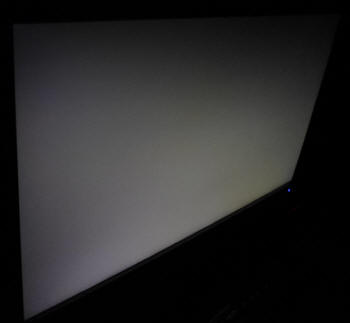
Above: View of an
all black screen from the side. Click for larger version
On a black image there is a characteristic white
glow when viewed from an angle, commonly referred to as IPS-glow. This is common
on most modern IPS panels and can be distracting to some users. If you view dark
content from a normal head-on viewing position, you can actually see this glow
as your eyes look towards the edges of the screen if the screen is of a large
size. This could be distracting if you work with a lot of dark
content. The IPS glow was normal here for a modern IPS-type panel. While the
general viewing angles of IPS technology are better than TN Film, this IPS glow
is one area where they are not as well off.

Panel Uniformity
We wanted to test
here how uniform the brightness and colour temperature was across the screen, as well as identify any
leakage from the backlight in dark lighting conditions. Measurements of the luminance
and colour temperature were taken at 35 points across the panel on a pure
white background. The measurements for luminance were taken using BasICColor's calibration
software package, combined with an X-rite i1 Display Pro
colorimeter with a central point on the screen calibrated to 120 cd/m2. Measurements for colour temperature (white point) were taken using
BasICColor software and the i1 Pro spectrophotometer which can more accurately
measure the white point of different backlighting technologies. The below uniformity diagram shows the difference, as a percentage,
between the measurement recorded at each point on the screen, as compared with the
central reference point.
It is worth
noting that panel uniformity can vary from one screen to another, and can depend
on manufacturing lines, screen transport and other local factors. This is only a
guide of the uniformity of the sample screen we have for review.

Uniformity of Luminance

The luminance uniformity of the screen was
moderate. The top and left hand edges did
seem to drop down in luminance somewhat, ranging down to 99
cd/m2
in the most extreme cases in the central upper area. The lower and central
regions of the screen were a bit more uniform. Around 60% of the screen was within a 10% deviance
from the centrally calibrated point which was ok.

Backlight Leakage
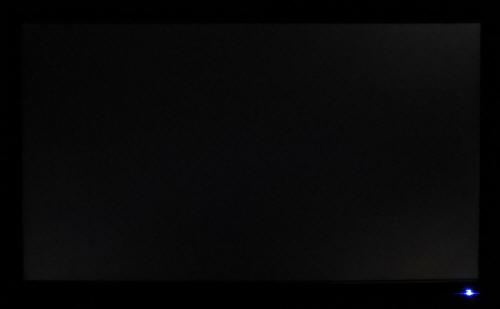
Above: All black screen in a darkened room. Click for larger version
As usual we also tested the screen with an all
black image and in a darkened room. A camera was used to capture the result. The
camera showed there was some clouding
detected in the right hand corners. It was not too bad
though, not easy to pick out with the naked eye, and should not present any major problems in normal use.

General and Office Applications
The XB270HU feature a large 2560 x 1440 WQHD
resolution which is only just a little bit less vertically than a 30" screen.
The pixel pitch of 0.233 mm is quite small as a result, and by comparison a
standard 16:10 format 24" model has a pixel pitch of 0.270mm and a 30" model has
0.250mm. These ultra-high resolution 27" models offer a tight pixel pitch and
therefore small text as well. We found it quite a change originally coming from
21.5 - 24" sized screens back in the day, even those offering quite high
resolutions and small pixel pitches. Although now we are very used to working
with 27" 1440p screens all the time and find them very comfortable and a
significant upgrade over 1080 / 1200p models. Some users may find the small text
a little too small to read comfortably, and we'd advise caution if you are
coming from a 19" or 22" screen for instance where the pixel pitch and text are
much larger. The extra screen size takes some getting used to over a few days as
there really is a lot of room to work with but once you do, it's excellent. For
those wanting a high resolution for CAD, design, photo work etc, this is a
really good option. The image was very sharp and crisp and text was very clear.
With its
WQHD display, you enjoy 77% more desktop space than a full HD screen to spread
out your windows and palettes.
The thin
bezel design mean that the XB270HU could be easily integrated into a
multi-screen set up if you wanted. It doesn't have a 'frameless' design like
some modern screens, but it's certainly not a thick bezel. The light AG coating of the
modern AHVA (IPS-type) panel is
certainly welcome, and much better than the older grainy and 'dirty' appearance
of older IPS AG coatings.
The wide
viewing angles provided by this panel technology on both horizontal and
vertical planes, helps minimize on-screen colour shift when viewed from
different angles.
The default setup of the screen was pretty decent,
offering a strong contrast ratio and low dE. Ideally you will want to calibrate
the screen with a colorimeter to correct the gamma curve, but even without we
thought the image looked decent enough for day to day office work. A few simple
OSD changes can help you adjust the colour temperature as well to get a warmer
setting, or something closer to 6500k at least.
The brightness
range of the screen was also very good, with the ability to offer a luminance
between 327 and 53 cd/m2. This should mean the screen is perfectly
useable in a wide variety of ambient light conditions, including darkened rooms.
A setting of ~20 in the OSD brightness control should return you a luminance
close to 120 cd/m2 out of the box. On another positive note, the brightness
regulation is controlled without the need for the use of the now infamous
Pulse-Width Modulation (PWM), and so those who suffer from eye fatigue or
headaches associated with flickering backlights need not worry. One minor gripe
is that the brightness control in the OSD menu is really slow to move, so if you
are adjusting across a wide range it can take a while.
There was no
audible noise or buzzing from the screen, even when specifically looking for it
using test images with a large amount of text at once. The screen also remains
fairly cool even during prolonged use. There is no specific preset mode for
office work or reading. The eColor preset modes are locked at certain brightness
levels as well, so aren't really suitable for general office/text work. You'd be
best off using the 'user' mode and adjusting the brightness control to suit your
requirements and ambient light conditions. There is only 1x DisplayPort
connection here so connectivity is limited for some older systems. It's designed
primarily for gaming and G-sync limitations call for just the single DisplayPort
connection at the moment.
The screen offers 4x USB 3.0 ports which can be
useful and it was nice to keep this up to date with the modern version. Here, 2 of them are on the underside back with the
video connections, and 2 are on the left hand side of the screen for easy
access. One of those on the left hand side can be used for charging as well
which is handy.
There are no further extras like ambient light
sensors or card readers which can be useful in office environments. Remember,
this is aimed at gamers really. There was a great range of ergonomic adjustments
available from the stand allowing you to obtain a comfortable position for a
wide variety of angles. The VESA mounting support may also be useful to some
people as well.

Above: photo of
text at 2560 x 1440 (top) and 1920 x 1080 (bottom)
The screen is designed to run at its native
resolution of 2560 x 1440 and at a 60Hz recommended refresh rate. However,
if you want you are able to run the screen outside of this resolution. We tested
the screen at a lower 1920 x 1080 resolution to see how the screen handles the
interpolation of the resolution, while maintaining the same aspect ratio of
16:9. At native resolution the text was very sharp and clear. When running at a 1080p resolution the text is still
reasonably clear, with moderate
levels of blurring. You do lose some screen real-estate as well of course but
the image seems to be interpolated quite well from 1080p sources.

Gaming Introduction

The Acer XB270HU is very exciting when it comes to
gaming for various reasons. Firstly, this is the first IPS-type panel on the
market to natively support refresh rates up to 144Hz. Some Korean model IPS
screens have been "overclockable" up to 100 - 120Hz or so over the last couple
of years, but results vary a lot and it's by no means a native support from a
panel level. Furthermore, from what we've seen of Korean screens the response
times never seem to be up to much and don't reach low enough levels that make
the screen practical for the frame rate demands that the high refresh rate has.
A lot of blurring and ghosting is common on those models as a result. We will
test in the following sections how the pixel response times are, but the first
thing to note is that this panel is designed to operate with the high refresh
rate natively. Secondly, this is the first IPS-type panel to support NVIDIA's
G-sync dynamic refresh rate technology. We already know that this is an
extremely effective alternative to Vsync methods and adds a significant
performance advantage when used in games with variable frame rates and on
systems of differing capabilities. Thirdly, this is the first IPS-type panel to
feature any kind of blur reduction mode at all. This comes in the form of the
Ultra Low Motion Blur (ULMB) feature which is linked to the G-sync module. It
should be noted that despite the high refresh rate support, the XB270HU does not
support NVIDIA 3D Vision - we tested it just in case but it doesn't detect the
display as a compatible screen.
|
IPS-type panel technology |
 |
|
Native high refresh rate
support |
 |
|
G-sync support |
 |
|
Ultra Low Motion Blur (ULMB) |
 |
|
NVIDIA 3D Vision |
 |
To make the most of the Acer XB270HU you will want
a suitable NVIDIA graphics card. The screen is designed in conjunction with
NVIDIA and certain features including
G-sync and the
Ultra Low Motion Blur (ULMB)
mode only work with NVIDIA GPU's. You will need
a graphics card from their range which supports G-sync, from the list provided
on
NVIDIA's website. You will also need to ensure that the graphics card has a
DisplayPort output since the screen only has a single DisplayPort input. A lot
of NVIDIA's graphics cards seem to omit this connection type (as it's more of an
AMD connection), but some versions of their compatible cards do offer it. You
can't unfortunately use regular and widely available DVI to DisplayPort adapters
as they don't work when taking DVI output from the graphics card to DP input in
the monitor. There may be some "active" adapters which could overcome this, but
that might be hit and miss. Ensuring you have a suitable NVIDIA card with DP out
will make life much easier. If you have an older NVIDIA card with DP output
which does not support G-sync, you can still run the screen as normal. You
would be able to achieve the 144Hz refresh rate but you wouldn't be able to use
G-sync or ULMB which are linked to one another and only available on the more
modern G-sync supporting cards. On another note, you might find different
DisplayPort cables give you different results. Some we had lying around our lab
didn't seem to work very well, but you can just use the bundled cable anyway
which should be fine.
It should be noted that the screen can also be
used from AMD graphics cards, again as long as you have a DisplayPort output. We
didn't have any issues with achieving the maximum refresh rate on one of our
test machines (AMD 7800 series). We'd had problems reaching 120 / 144Hz when we
tested the Asus ROG Swift PG278Q from the same graphics card, but no problems
here on the Acer. Results may vary from one setup to another. Again, you'd
probably have an NVIDIA card anyway if you were going to buy this screen since a
lot of what you're paying for is the G-sync / ULMB features. Some users might
still want to buy the screen to run on AMD systems, since after all it is still
the World's first 144Hz compatible IPS-type panel. For optimum usage you want to
be pairing it with an NVIDIA G-sync card though.
We expect if you're looking at such a high end
gaming display that you will also have a pretty high end gaming PC to run it, so
2560 x 1440 at 144Hz would of course be preferable over anything else. You will
see from our forthcoming
response
time tests that the increased refresh rate has a positive impact on response
times as long as you stick to the 'normal' OD setting. What we are trying to say
here is that we hope you have a system powerful enough to run this screen at its
intended 2560 x 1440 resolution and 144Hz refresh rate, as really that's where
you will get the optimum performance. You do need to consider the power of your
graphics card though as there will be a big demand on your system for gaming at
these kind of settings. Fortunately though there is also the new NVIDIA
G-sync technology which will offer you smooth gaming even at lower frame
rate outputs. Read on for more information.

Responsiveness and Gaming
|
Quoted G2G Response Time |
4ms G2G |
|
Quoted ISO Response Time |
n/a |
|
Panel Manufacturer and
Technology |
AU Optronics |
|
Panel Part |
M270DAN02.3 |
|
Overdrive Used |
Yes |
|
Overdrive Control Available to
User |
'OD' |
|
Overdrive Settings |
Off, Normal, Extreme |
The XB270HU is rated by Acer as having a 4ms G2G response time, which indicates the panel uses
overdrive /
response time compensation (RTC) technology to boost pixel transitions
across grey to grey changes. There is user control over the overdrive impulse
within the OSD menu using the 'OD' (Overdrive) option. The
part
being used is the
AU Optronics M270DAN02.3 AHVA (IPS-type) panel. Have a read about response time in
our
specs section if you need additional information about this measurement.
We will first test the screen using our thorough
response time testing method. This uses an oscilloscope and photosensor to
measure the pixel response times across a series of different transitions, in
the full range from 0 (black) to 255 (white). This will give us a realistic view
of how the monitor performs in real life, as opposed to being reliant only on a
manufacturers spec. We can work out the response times for changing between many
different shades, calculate the maximum, minimum and average grey
to grey (G2G) response times, and provide an evaluation of any overshoot present
on the monitor.
We use an
ETC M526
oscilloscope for these measurements along with a custom photosensor device.
Have a read of
our response time measurement article for a full explanation of the testing methodology and reported
data.
Response Time Setting Comparison
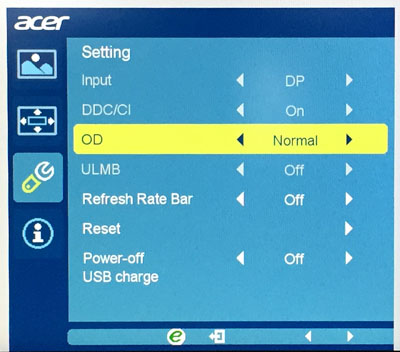

The XB270HU comes with a user control for the
overdrive impulse available within the OSD menu in the 'settings' section as
shown above (top), using the 'OD' option. You can also access it via one of the
quick access menus (bottom). There are 3 options available here in
the menu, for off, normal and extreme modes.
First of all we carried out a smaller sample set
of measurements in all three of the OD response time settings. These, along with various
motion tests allowed us to quickly identify which was the optimum overdrive setting
for this screen. For completeness we tested the response times in each of these
OD modes at various refresh rates, ranging from a normal 60Hz, up to the maximum
144Hz. This allowed us to establish if there were any differences in response
time behaviour at each refresh rate as well.
|
OD (Overdrive)
Setting = Off |
|
60Hz |
 |
|
120Hz |
 |
|
144Hz |
 |
With OD set first of all to 'off' the response
time behaviour was basically the same no matter what refresh rate was used. The
average G2G response time was a modest ~11ms which actually put it only slightly
behind some of the other IPS-type 27" models we have tested like the Dell U2715H
(9.9ms) and BenQ GW2765HT (10.1ms), even when those were set to their optimum
overdrive setting. Considering this was the lowest OD setting this seems to bode
well for the response times of this panel. Rise times were slower than fall
times, but neither showed any overshoot at all.
|
OD (Overdrive)
Setting = Normal |
|
60Hz |
 |
|
120Hz |
 |
|
144Hz |
 |
Moving the OD control up to 'Normal' we saw some
obvious improvements to the response times. At 60Hz refresh rate the average G2G
response time had reduced to 8.7ms, putting it on par with the best IPS-type
panels we've seen to date where overshoot was not a problem (models like the
Dell U2415 = 8.6ms). There was no overshoot at all detected either on this model
so this was very pleasing.
It's when you switch the refresh rate up that the
magic starts to happen! At 120Hz, the response times speed up quite
significantly, with an average G2G now measured at 6.3ms. Bumping the refresh
rate up to 144Hz pushes the response times even more, down now to 5.9ms G2G
which is amazing for an IPS-type panel! It seems that the refresh rate has an
impact on the overdrive impulse, pushing the response times down as you increase
the refresh rate. This is more clear in the following section where we test the
'Extreme' OD setting, but you can see a very minor amount of overshoot starts to
appear in the 'Normal' mode when you reach 144Hz. Nothing at all which you would
see in practice, so we would consider OD Normal and 144Hz to be an excellent
setting for response times. AU Optronics
and Acer have obviously done a great job with the panel and monitor overdrive
circuit.
With high refresh rates it it important that the
response times can keep up with the demands of the frame rate. At 60Hz a new
frame is sent to the screen every 16.6ms, at 120Hz every 8.33ms, and at 144Hz
every 6.94ms. The response times need to be at least as fast as this to keep up,
and thankfully they are on this screen. A truly impressive result for an
IPS-type panel. If you're using G-sync then the refresh rate will be controlled
dynamically depending on your gaming content and frame rate output from the
graphics card. The overdrive impulse will be controlled dynamically at the same
time, and pixel response times will range between 8.7 and 5.9ms G2G (60 - 144Hz)
as a result, being more than capable of handling the frame rate at whatever
refresh rate is running.
|
OD (Overdrive)
Setting = Extreme |
|
60Hz |
 |
|
120Hz |
 |
|
144Hz |
 |
Pushing the OD control up to the maximum 'Extreme'
setting brought about some further changes in pixel response time behaviour. It
also more clearly demonstrated what is happening to response times when you
increase the refresh rate. At 60Hz the G2G average has been reduced from 8.7ms
down to 7.0ms although some overshoot has now been introduced at pretty high
levels. When you increase the refresh rate to 120Hz, and then to 144Hz you see a
further drop in response times like we had seen in the 'Normal' OD mode.
However, the overshoot becomes far more problematic and reaches ridiculous
levels by the time you're running at 144Hz. For example the 0-50 transition has
an overshoot of 21.2% at 60Hz, growing to 85% at 120Hz and then a whopping 111%
at 144Hz. This demonstrates that the overdrive impulse is affected by the
refresh rate of the screen, helping to speed up response times, but at the same
time causing more overshoot in this mode. As a result of the high overshoot we
wouldn't recommend using the 'Extreme' mode. Stick with 'Normal' where the
response times are excellent for an IPS-type panel, and there's no overshoot at
any refresh rate.
Overshoot Comparison at Different Refresh Rates
(OD = Extreme)
If we compare the same 0-50-0 transition response
time graph at each of the three refresh rate settings you can get a clearer view
of what is happening. All 3 below are at the same scale, and the only thing
changed each time was the Windows refresh rate.
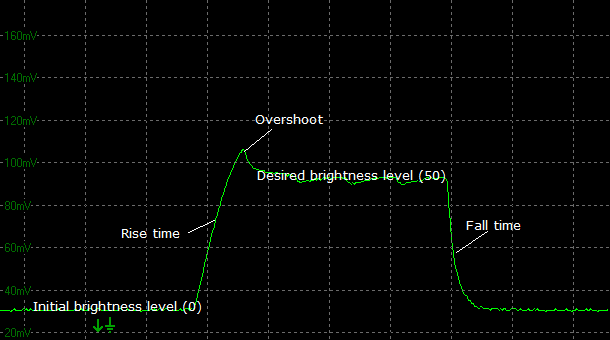
Transition: 0-50-0
(scale = 20ms), refresh rate 60Hz
We have annotated this graph to help explain a
little more clearly. At 60Hz refresh rate the upward curve is not as steep,
showing it is a little slower to reach the desired luminance and which equates
to the rise time measured of 8.6ms. There is a small overshoot where the
brightness exceeds the target (21.2%) before dropping back down to the desired
level, represented by the top flat line. The fall time is then measured at 5.9ms
and that curve is steeper than the rise time as a result.
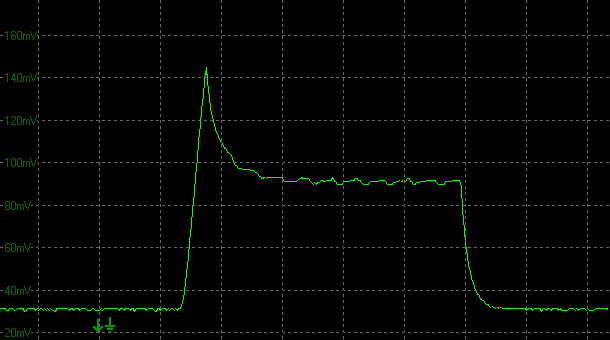
Transition: 0-50-0
(scale = 20ms), refresh rate 120Hz
When switching up to 120Hz there are a couple of
obvious changes. The rise time is now quicker, measured at only 3.4ms now and
represented by the steeper upward curve of the graph compared with before.
However, the overshoot is significantly more, measured here at 85% and shown by
the much higher peak.

Transition: 0-50-0
(scale = 20ms), refresh rate 144Hz
Again changing up to 144Hz maximum refresh rate
brings about some changes. The upwards curve is steeper still, and we measured a
2.6ms rise time. The overshoot has grown again though, this time to 111.0% which
is massive!

Click for larger
version
If we take some test photos using the PixPerAn
tool you can make some further visual comparisons between the overdrive settings
and refresh rates. With OD set to off, there were consistent levels of blur to
the moving image, regardless of the refresh rate setting. This matched up with
what we'd measured with our oscilloscope as well. When you move to the 'normal'
OD setting you see a marked improvement in response times, even at a basic 60Hz
refresh rate. The blurring has been reduced nicely and the moving image appears
sharper. This improves as you switch up to 120Hz and then 144Hz, with the image
becoming clearer as the above photos capture. Not only are you getting a huge
improvement in frame rate and smoothness brought about by the higher refresh
rate, but you are getting improvements to the pixel response times as well. At
the 'extreme' setting you can see some dark trailing in the 60Hz mode, but
actually nothing too major. When you move up to 120Hz and then 144Hz, there is
some pale trailing introduced as well and the overshoot is at very high levels.
To reiterate, we would recommend sticking with normal OD setting.

More Detailed Measurements
OD = Normal and 144Hz refresh rate
Having established that the OD 'normal' mode offered
the best response/overshoot balance we carried out our normal wider range of
measurements as shown below. Tests were completed at the maximum 144Hz refresh
rate.
 
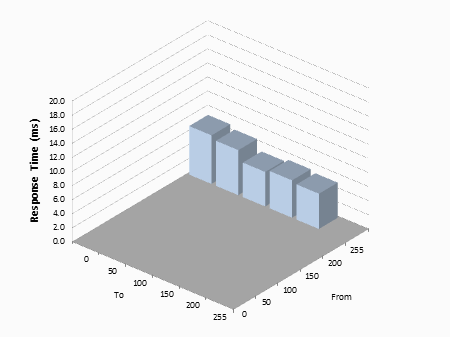
The average G2G response time was more accurately
measured at 5.5ms which was excellent overall, especially for an IPS-type panel. Rise times
and fall times were very similar on average so so transitions were fairly
consistent across the board.
This was a very pleasing result and we were very impressed.
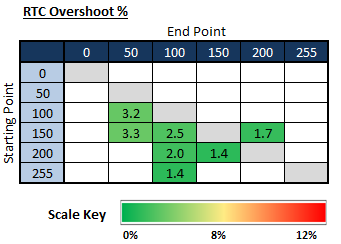
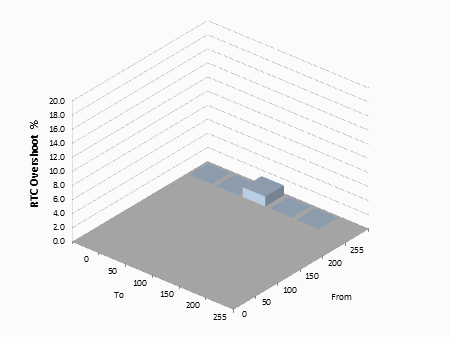
There was some very minor overshoot on some
transitions but nothing at all to worry about. Considering how low the response
times were driven on this IPS-type panel we were amazed that there was no
overshoot to speak of as long as you stick to this 'normal' OD mode. The higher
'extreme' setting had far more noticeable overshoot, especially at the higher
refresh rates.

Transition: 100-200-100 (scale =
20ms)
Above is a fairly typical response time curve
example using the OD = normal mode and 144Hz. The rise time curve is very steep
and measures at 4.9ms. The fall time is very similar and measures at 5.0ms.
There is some very minor overshoot of 2% on the fall time.

Display Comparisons
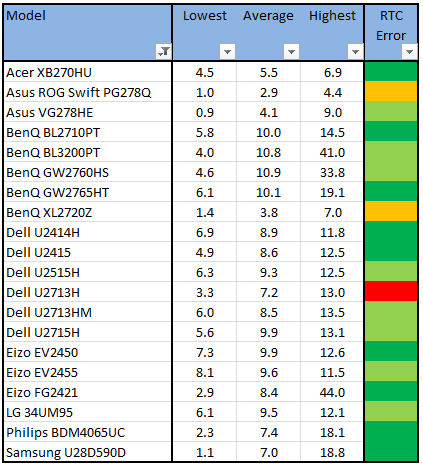
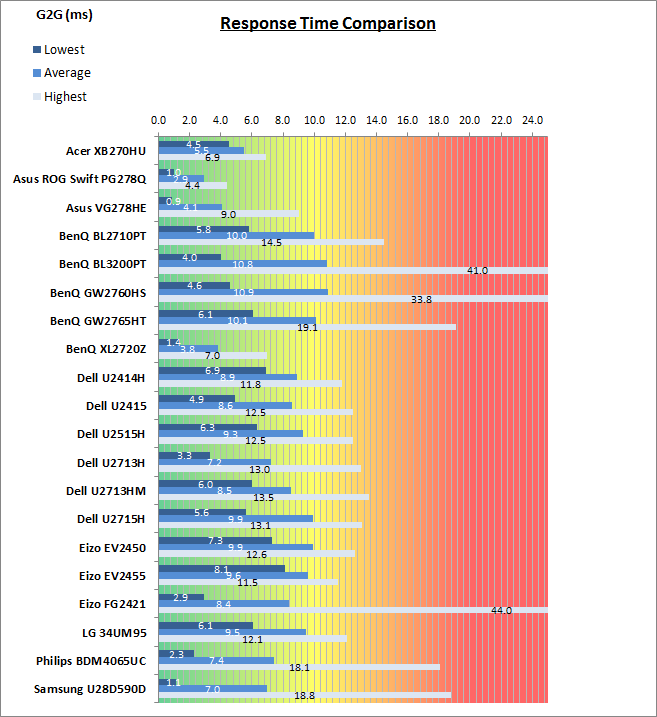
The above comparison table and graph shows you the
lowest, average and highest G2G response time measurement for each screen we
have tested with our oscilloscope system. There is also a colour coded mark next
to each screen in the table to indicate the RTC overshoot error, as the response
time figure alone doesn't tell the whole story.
The response time performance of the XB270HU was
very impressive indeed. It's the first 144Hz capable IPS-type panel on the
market so it needed to be able to deliver when it comes to pixel response times.
With an average G2G figure of 5.5ms measured, it was much faster than any other
IPS panel we have seen to date, at best reaching down to 8.6ms without
introducing a lot of overshoot (Dell U2415). It was pushing past some TN Film
screens even like the Samsung U28D590D (7ms G2G average). It wasn't quite as
fast as pure gaming TN Film models like the Asus ROG Swift PG278Q (2.9ms) and
BenQ XL2720Z (3.8ms) although those models did show a moderate level of
overshoot so it's debatable which is better. It was just really pleasing to see
IPS response times reach this low and without any sign of overshoot problems as
well.
The screen was also tested using the chase test in
PixPerAn for the following display comparisons. As a reminder, a series of
pictures are taken on the highest shutter speed and compared, with the best case
example shown on the left, and worst case example on the right. This should only
be used as a rough guide to comparative responsiveness but is handy for a
comparison between different screens and technologies as well as a means to
compare those screens we tested before the introduction of our oscilloscope
method.

27"
4ms
G2G AU Optronics AHVA (IPS-type) @ 144Hz (OD = Normal)
In practice the Acer XB270HU performed best with
the Overdrive setting on 'normal'. Motion blur was minimal and the moving image
looked sharp and crisp. Motion felt very fast and fluid thanks to the 144Hz
refresh rate, something which you can't really pick out with the camera. There
was no overshoot detected at all which was equally as pleasing as the fast
response times.

27"
4ms
G2G AU Optronics AHVA (IPS-type) @ 144Hz (OD = Normal)

27" 4ms G2G AU
Optronics AHVA (AMA Setting = High)

27" 12ms G2G
Samsung PLS (Response Time = Advanced)

27"
8ms
G2G LG.Display AH-IPS (Response Time = Normal)

27" 8ms G2G
LG.Display AH-IPS
Firstly it is interesting to compare the XB270HU to some of the other popular 27"
models we have tested with 2560 x 1440 resolutions and IPS-type panels (IPS, PLS
and AHVA). You can
see first of all a comparison against the
BenQ BL2710PT,
ViewSonic VP2770-LED and
Dell U2715Hwhich show a more noticeable blurred image. The
Dell U2713HM
is a little faster, but in practice cannot compete with the speed of the XB270HU
still. The movement is clearer and smoother on the XB270HU, and you also have the
massive benefit of the 144Hz refresh rate. Not to mention further gaming
enhancements like G-sync and ULMB which we will cover in a moment.

27"
4ms
G2G AU Optronics AHVA (IPS-type) @ 144Hz (OD = Normal)

27"
1ms
G2G AU Optronics TN Film @ 144Hz (OD = Normal)

27" 1ms G2G
AU Optronics TN Film + 144Hz (AMA = High)

23.5" 4ms G2G
Sharp MVA + 120Hz
This is where the real comparisons are! We've also included a comparison above against
3 other very fast 120Hz+ compatible screens we have tested. The screens shown
here are all aimed primarily at gamers and have various features and extras
which make them more suitable overall for gaming, much like the XB270HU.
Firstly there is a comparison against the very popular
Asus ROG Swift PG278Q with its 144Hz refresh rate and fast response time TN
Film panel. This showed very fast pixel response times and smooth movement
thanks to its increased refresh rate. You are able to reduce the motion blur
even more through the use of the ULMB strobed backlight as well if you need to.
In other related areas this screen also supports NVIDIA's G-sync technology.
There was some overshoot noticeable on the Asus but nothing major.
Then there is a comparison against the
BenQ XL2720Z with another very fast TN Film panel and 144Hz refresh rate.
This showed very low levels of motion blur, but some dark overshoot was
introduced as a side-effect as you can see. This screen also includes a native
Blur Reduction mode to help eliminate further perceived motion blur and works
well.
Lastly there is the MVA based Eizo FG2421 screen
with a fast response time (especially for the panel technology being used) and
120Hz refresh rate support. There is also an additional 'Turbo 240' motion blur
reduction mode which really helps reduce the perceived motion blur in practice.
All things considered we felt that the Acer
XB270HU performed the best in these specific tests. The response times were
slightly slower than the Asus ROG Swift PG278Q and BenQ XL2720Z, but the benefit
of that was that there was no overshoot on the Acer, whereas the others showed
some moderate levels. The Acer also has a
native blur
reduction mode (ULMB) and G-sync support which we will look at shortly. One other thing to note
here is that with the exception of the Asus ROG Swift PG278Q these other screens can only support a maximum 1920 x 1080
resolution, and so there's a huge jump in resolution and image quality when
extending to a 2560 x 1440 panel in the XB270HU. You get the
not-to-be-underestimated benefits of the IPS-type panel as well from the Acer,
with wider viewing angles and a more stable image appearance compared with the
TN Film models. Overall a very impressive performance from the XB270HU.

G-Sync
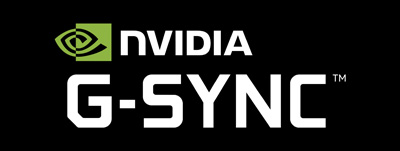
Obviously a huge part of the Acer XB270HU is
the addition of NVIDIA's new G-sync technology. We covered this in our Asus ROG
Swift PG278Q review as well, but we think it's worth repeating here. We thought it would be useful to
give you some background on what G-sync is and what it offers. As an introduction,
monitors typically operate
at a fixed refresh rate, whether that is 60, 120 or 144Hz. When running
graphically intense content like games, the frame rate can of course fluctuate
somewhat and this poses a potential issue to the user. There are traditionally
two main options available for how frames are passed from the graphics card to
the monitor using a feature called VSYNC, whether Vsync is turned on or off.
Vsync Overview
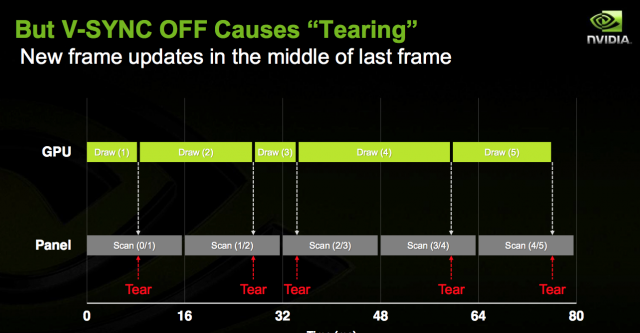
At the most basic level
‘VSync
OFF’
allows the GPU to send frames to the monitor as soon as they have been
processed, irrespective of whether the monitor has finished its refresh and is
ready to move onto the next frame. This allows you to run at higher frame rates
than the refresh rate of your monitor but can lead to a lot of problems. When
the frame rate of the game and refresh rate of the monitor are different, things
become unsynchronised. This lack of synchronisation coupled with the nature of
monitor refreshes (typically from top to bottom) causes the monitor to display a
different frame towards the top of the screen vs. the bottom. This results in
distinctive
‘tearing’
on the monitor that really bothers some users. Even on a 120Hz or 144Hz monitor,
where some users incorrectly claim that there is no tearing, the tearing is
still there. It is generally less noticeable but it is definitely still there.
Tearing can become
particularly noticeable during faster horizontal motion (e.g. turning, panning,
strafing), especially at lower refresh rates.
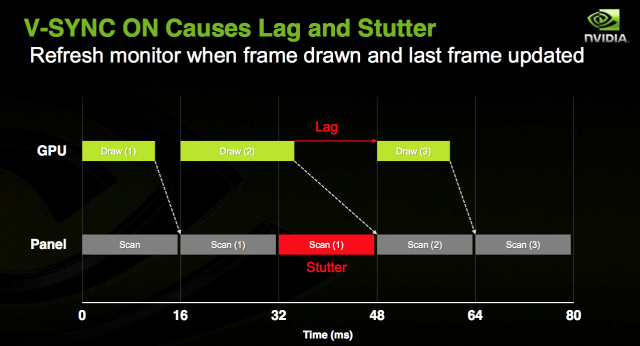
The solution to this tearing problem for many
years has been the
‘VSync
ON’
option which essentially forces the GPU to hold a frame until the monitor is
ready to display it, as it has finished displaying the previous frame. It also
locks the frame rate to a maximum equal to the monitor’s refresh rate. Whilst
this eliminates tearing, it also increases
lag
as there is an inherent delay before frames are sent to the monitor. On a 120Hz
monitor the lag penalty is half that of a 60Hz monitor and on a 144Hz
monitor is even lower. It is still there, though, and some users feel it
disconnects them from game play somewhat. When the frame rate drops below the
refresh rate of the monitor this disconnected feeling increases to a level that
will bother a large number of users. Some frames will be processed by the GPU more slowly than the monitor is able to display them. In other words the
monitor is ready to move onto a new frame before the GPU is ready to send it. So
instead of displaying a new frame the monitor displays the previous frame again,
resulting in
stutter.
Stuttering can be a major problem when using the Vsync on option to reduce
tearing.
During Vsync ON operation, there can also
sometimes be a sudden slow down in frame rates when the GPU has to work harder.
This creates situations where the frame rate suddenly halves, such as 60 frames
per second slowing down to 30 frames per second. During Vsync ON, if your
graphics card is not running flat-out, these frame rate transitions can be very
jarring. These sudden changes to frame rates creates sudden changes in lag, and this can disrupt
game play, especially in first-person shooters.
NVIDIA G-sync Variable
refresh rate solution
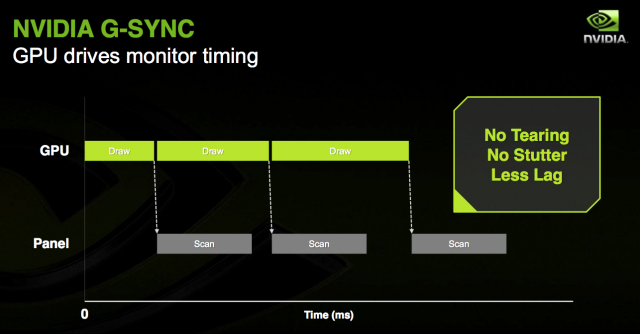
To overcome these
limitations with Vsync, NVIDIA have just introduced a new technology they have
dubbed G-sync. This technology can be integrated into monitors to allow them to
adopt a variable refresh rate, dynamically altering the monitor depending on the
graphics card output and frame rate. The frame rate of the monitor is still
limited in much the same way it is without G-SYNC, but it adjusts dynamically to
a refresh rate as low as 30Hz to match the frame rate of the game. By doing this
the monitor refresh rate is perfectly synchronised with the GPU. You don’t get
the screen tearing or visual latency of having Vsync disabled, nor do you get
the stuttering or input lag associates with using Vsync. You can get the benefit
of higher frame rates from Vsync off (within the G-sync range of 30Hz - 144Hz)
but without the tearing, and without the lag and stuttering caused if you switch
to Vsync On.
We don't want to go into too much depth about game
play, frame rates and the performance of G-sync here as we will end up moving
away from characteristics of the monitor and into areas more associated with the
operation of the graphics card and its output. G-sync is a combined graphics
card and monitor technology, but from a monitor point of view all it is doing is
supporting this feature to allow the graphics card to operate in a new way.
There are plenty of reviews and tests of G-sync online which cover the operation
of G-sync in more detail. Our friends over at
http://www.blurbusters.com/ have done some G-sync testing in various games
which is well worth a read. They've also carried out
various lag
tests which have confirmed that using G-sync doesn't seem to add any
noticeable lag, compared with running with Vsync off.
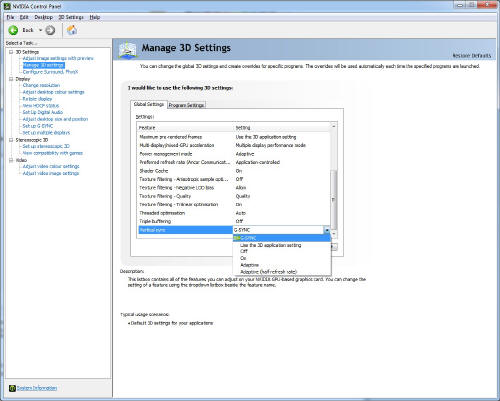
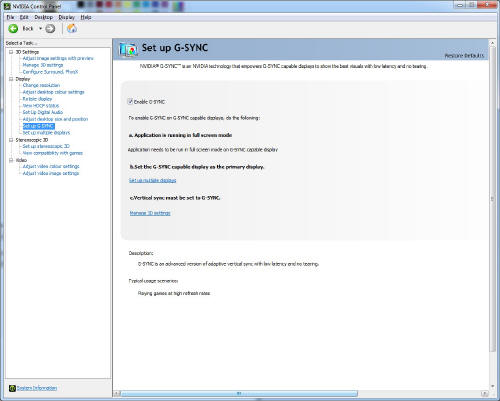
Above: G-sync
options in the NVIDIA control panel
We did run some tests using Battlefield 4 to see
how it worked ourselves. In Battlefield you will experience a lot of varying
frame rates due to the changes in scenery and the complexity of your
surroundings. Playing with G-sync enabled allowed the monitors refresh rate to
synchronise with the graphics card frame rate, and this nicely removed the
stutter we saw from using Vsync. It also meant there was no tearing like you'd
see from having Vsync off which of course is a massive bonus. We were very
impressed by the fluidity and smoothness of motion and the absence of artefacts
which can be easily detected in similar conditions when using Vsync on or Vsync
off. We'd encourage you to read some of the G-sync reviews online as they go
into a lot more detail about graphics card rendering, frame rates etc as well.
It should be noted that the real benefits of
G-sync really come into play when viewing lower frame rate content, around 45 -
60fps typically delivers the best results compared with Vsync on/off. At
consistently higher
frame rates as you get nearer to 144 fps the benefits of G-sync are not as
great, but still apparent. There will be a gradual transition period for each
user where the benefits of using G-sync decrease, and it may instead be better
to use the ULMB
feature discussed in the following section which is not available when using
G-sync. Higher end gaming machines might be able to push out higher frame rates
more consistently and so you might find less benefit in using G-sync. The ULMB
could then help in another very important area, helping to reduce the perceived
motion blur caused by LCD displays. Keeping in mind that the XB270HU features a
large 2560 x 1440 resolution, you'd need a pretty powerful system to achieve
consistently high frame rates, so we'd encourage you to try G-sync of course to
see how it affects your gaming usage. It's nice to have both G-sync and ULMB
available to choose from certainly. Well done Acer!
For more information on G-sync from NVIDIA, please
visit their website:
http://www.geforce.co.uk/hardware/technology/g-sync
|
Check Pricing and Buy
You can
help to support TFTCentral by purchasing your display and other hardware
via our affiliate links below. This helps us earn a small referral fee for
any purchase you make and contributes towards the ongoing running of this
site. Thank you. |
|
Amazon USA |
Amazon UK |
Overclockers UK |
Amazon GER |
Amazon CAN |

Ultra Low Motion Blur (ULMB)
The Acer XB270HU also features an integrated Blur
Reduction Backlight system, dubbed "Ultra Low Motion Blur" (ULMB). We have
already seen a lot of positive improvements in perceived motion blur from such
systems in the past. Our
in depth article from June 2013 looked at this in a lot
more detail, and tested some of the original LightBoost "hacks" to achieve a
strobed backlight and blur reduction benefits. Since then we've seen a couple of
monitors integrate a similar strobed backlight with simple user control from the
menu. The
Eizo Foris FG2421 and
BenQ XL2720Z both had useful
integrated blur reduction
modes built in to the screen. We first saw the ULMB feature when we tested the
Asus ROG Swift PG278Q
last July. This will be the first IPS-type panel though to feature a blur
reduction mode of any type so it's really interesting to see how this performs.

The ULMB feature is accessible from the 'setting'
section of the OSD menu as shown above.

For quick switching on and off it is also
available via the quick launch menu
option. It is only available when running the screen at 85 and 100Hz modes (see
update below). The lack of support at the high refresh rates is probably
related to a couple of factors. Mark Rejhon at Blurbusters.com talks about it a
little
in his post here as well. Firstly, to have effective "clean" strobing at
120Hz you really need pixel response times to be able to reach ~1ms G2G ideally,
something that this IPS-type panel cannot reach. Even the best TN Film panels
struggle to reach that kind of response time, so the strobing provided at 120Hz
is still not clean. By limiting the ULMB to 100Hz maximum it is more appropriate
for the kind of response times made possible from this new panel - which are
excellent it should be noted for an IPS variant.
Secondly when you are using the ULMB feature you
cannot use G-sync. As a result you are restricted to the Vsync on/off situation
which we
discussed earlier in the review. Limiting the refresh rate to 100Hz maximum
is less of a drain on graphics resources than 120HZ/144Hz. You'd still need a
beefy graphics capability to be able to output 100 fps consistently at 2560 x
1440 resolution, so we don't feel that the upper restriction here is really a
massive issue. You still get fast pixel response times, 100Hz refresh rate and
the benefits of perceived blur reduction discussed below.
Update 2/9/15: later versions of the XB270HU now
feature support for 120Hz ULMB as well
When you enable the ULMB
feature a new option appears in the OSD menu if you drill in to the ULMB option.
This new setting allows you to adjust the "Pulse Width". We will test that in a moment as well, but it allows you to
control the strobe length, and therefore adjust the visible persistence
somewhat. You can adjust this between 100 and 10, and as you lower the setting
the screen also becomes progressively darker as you reduce the "on" period of
the strobe. Nice to see this included as an option within the menu for those who
like to play around with the setting, much like you could do by adjusting
LightBoost levels on older models using the
"hack" method. There is no control to adjust the timing of the strobe to
impact the strobe cross-talk it can introduce, so we will have to hope that the default
timing setup is suitable. It should be noted that the brightness control when
using ULMB is independent to the brightness control you might be using in the
normal modes. So if you're using 20 brightness in the normal user mode and then
switch to ULMB it will be set at 100 until you change it to whatever you like.
This is good as you don't need to worry about turning brightness back up every
time you move over to ULMB mode which is naturally darker to start with because
of the strobing of the backlight.

Operation @ 85Hz
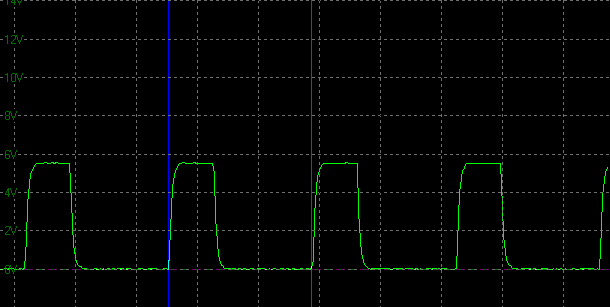
ULMB
backlight cycling, 85Hz
(scale = 5ms)
pulse width setting= 100
We measured the screen using our oscilloscope when
viewing a solid white image, with ULMB feature turned on and with
refresh rate set at 85Hz. This is the lowest refresh rate at which you can
operate the ULMB mode. As a reminder, it works at 85 and 100Hz only on this
screen. We
left the pulse width (strobe length) setting at 100 initially. Normally the oscillograph would show a flat straight
line when measuring a static white image (as no PWM is being used for backlight
dimming), but here the ULMB feature is cycling the backlight off and
on rapidly.
The time for each complete cycle is 11.76ms which
shows that in this case the backlight is being cycled at the same frequency as
the refresh rate, 85 times per second. The strobe is in time with the refresh
rate of 85Hz.

ULMB
backlight cycling, 85Hz
(scale = 5ms)
pulse width setting = 50
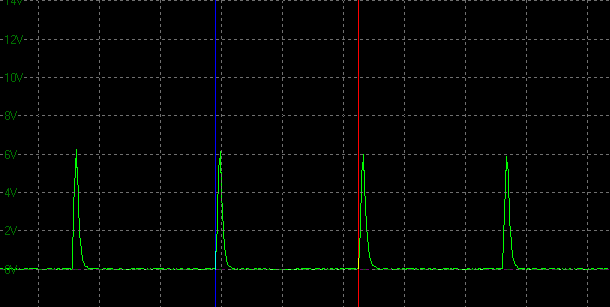
ULMB
backlight cycling, 85Hz
(scale = 5ms)
pulse width setting = 10
As you reduce the pulse width setting the strobe
'on' time gets progressively shorter as you can see from the above 2 graphs, the
first at a setting of 50 and the second at a setting of 10 (the minimum setting
available). This impacts the perceived blur somewhat, with the shorter 'on'
times resulting in a clearer image. At the same time though the brightness of
the image is affected and it becomes very dark, the lower you go with the
setting. More on that in a moment. There will be a point where the user does not
see any further benefit to their eyes of reducing the strobe length further, but
you can have a play around with the setting to find your personal preference to
balance perceived motion blur and brightness of the image.
Pulse Width Setting - Strobe Behaviour @
85Hz
We measured the strobe length at a variety of the
Pulse Width settings, while running at 85Hz refresh rate mode. You
can adjust the setting in steps of 1 incidentally. Oddly in the OSD the down
arrow moves the slider up towards 100, and the up arrow moves it down towards 0. Each complete strobe lasts a total of
11.76ms here a (85 strobes per second):
|
Pulse Width
Setting |
On period (ms) |
Off Period
(ms) |
|
100 |
3.625 |
8.135 |
|
75 |
2.750 |
9.010 |
|
50 |
1.875 |
9.885 |
|
25 |
0.875 |
10.885 |
|
10 (min) |
0.375 |
11.385 |
Pulse Width Setting - Brightness Range @
85Hz
|
Pulse Width
Setting |
Luminance
(cd/m2) |
Black
Point (cd/m2) |
Contrast
Ratio
( x:1) |
|
100 |
129.05 |
0.16 |
816 |
|
75 |
97.65 |
0.13 |
751 |
|
50 |
65.64 |
0.08 |
820 |
|
25 |
33.11 |
0.04 |
828 |
|
10 (min) |
13.38 |
<0.02 |
- |
We tested the brightness output of the screen when
ULMB was turned on at various pulse width settings. You can independently
control the brightness setting as well if you want, but we left it at the
default 100 and just changed the pulse width strobe length setting to establish the brightness range when using this
option. With the pulse width setting at 100 the maximum achievable luminance of
the screen was a moderate 129
cd/m2. This
should be enough for a lot of uses, but you cannot get a brighter display when
using ULMB if you wanted to. This is a typical performance from a strobe
backlight anyway and represented a decent enough luminance level. As you reduce
the
pulse width
setting the luminance drops significantly, at the lowest setting probably
being far too dark for any practical use. At least you can control a reasonably
wide range here, so you can find a level which suits your needs. We suspect a
setting of 100 will probably be adequate for most normal users anyway, as the
ULMB mode certainly brings about positive improvements to the perceived motion
blur.
Brightness Range @ 85Hz (Pulse Width at 100)
|
85Hz Refresh rate |
|
Brightness Setting |
Luminance
(cd/m2) |
Black
Point (cd/m2) |
Contrast
Ratio
( x:1) |
|
100 |
129.05 |
0.16 |
816 |
|
75 |
110.36 |
0.14 |
788 |
|
50 |
86.32 |
0.11 |
785 |
|
25 |
55.33 |
0.07 |
790 |
|
0 |
13.13 |
<0.02 |
- |
We also wanted to test the brightness range when
leaving the Pulse Width setting at its default 100, and changing the brightness control of the screen
instead. The table above confirms the range available through that control. At
85Hz refresh rate the maximum luminance you could achieve was 129
cd/m2. Some
users might find this too dark for some types of gaming and it's a shame you
can't use the ULMB at a higher luminance. The strobing of the backlight is the
reason for the reduced luminance compared with the normal mode of course. You
would need an even brighter backlight system to allow for brighter ULMB
operation. The 350 cd/m2 maximum rating of the W-LED unit used here
is pretty standard for modern desktop monitors.

Operation @ 100Hz

ULMB
backlight cycling, 100Hz
(scale = 5ms)
pulse width setting = 100
When running the screen at a 100Hz refresh rate
(max supported for ULMB)
the behaviour is exactly the same. The only difference is that the strobe is now
synced with the new refresh rate, with a new strobe every 10ms (100 times per
second). The strobing was less noticeable to the naked eye at 100Hz, as there
was a fairly noticeable visible flicker when running at 85Hz before, and it was
less obvious now.
Pulse Width Setting - Strobe Behaviour @
100Hz
We again measured the strobe length at a variety of the
Pulse Width settings, while running at the maximum 100Hz refresh rate mode
supported on this model. Each complete strobe lasts a total of
10ms (100 strobes per second):
|
Pulse Width
Setting |
On period (ms) |
Off Period
(ms) |
|
100 |
2.500 |
7.500 |
|
75 |
1.875 |
8.125 |
|
50 |
1.250 |
8.750 |
|
25 |
0.625 |
9.375 |
|
10 (min) |
0.250 |
9.750 |
Pulse Width Setting - Brightness Range @
100Hz
|
Pulse Width
Setting |
Luminance
(cd/m2) |
Black
Point (cd/m2) |
Contrast
Ratio
( x:1) |
|
100 |
110.54 |
0.14 |
790 |
|
75 |
82.78 |
0.10 |
828 |
|
50 |
55.51 |
0.07 |
793 |
|
25 |
27.99 |
0.04 |
700 |
|
10 (min) |
11.38 |
<0.02 |
- |
We tested the brightness output of the screen when
ULMB was turned on at various pulse width settings, again leaving the brightness
at the maximum 100 setting.
Brightness Range @ 100Hz (Pulse Width at 100)
|
100Hz
Refresh rate |
|
Brightness Setting |
Luminance
(cd/m2) |
Black
Point (cd/m2) |
Contrast
Ratio
( x:1) |
|
100 |
110.54 |
0.14 |
790 |
|
75 |
94.42 |
0.12 |
787 |
|
50 |
74.25 |
0.09 |
825 |
|
25 |
47.52 |
0.06 |
792 |
|
0 |
10.74 |
<0.02 |
- |
We also tested the brightness range of the screen
at a refresh rate of
100Hz, leaving the Pulse Width setting at the maximum of 100. The luminance was lowered slightly
compared with the 85Hz mode since the strobing was more frequent
at 100Hz, resulting in a slightly darker image.
Colour and Other Setup Characteristics
We wanted to test the impact on the setup of the
screen when enabling the ULMB feature to see whether it has a knock-on
effect to white point, gamma or colour accuracy. You can see straight away that
it impacts the luminance of the screen, which we've already looked at above.

Acer XB270HU - Calibrated Settings, ULMB Off

|
|
Calibrated Settings |
|
luminance (cd/m2) |
121 |
|
Black Point (cd/m2) |
0.12 |
|
Contrast Ratio |
1000:1 |
Above is our calibrated state from
earlier on
in the review, with the ULMB feature turned off.

Acer XB270HU - Calibrated Settings, ULMB On
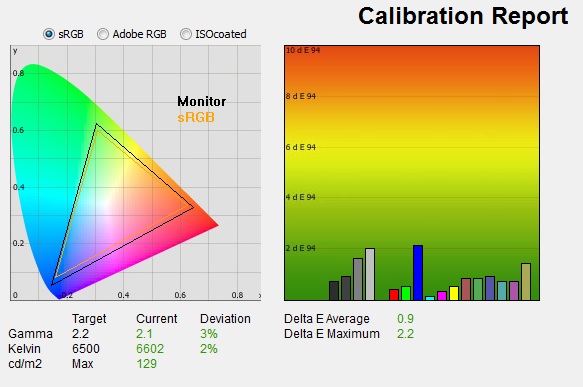
|
|
Calibrated Settings
ULMB On |
|
luminance (cd/m2) |
129 |
|
Black Point (cd/m2) |
0.16 |
|
Contrast Ratio |
816:1 |
We turned the ULMB mode on, but left the Pulse
Width option
at 100 here, and with the default maximum 100 brightness as well. We left our
calibrated ICC profile active from our initial calibration to see what immediate
impact the ULMB setting had on the colour performance. The gamma and white point
were skewed slightly here, with gamma now a little lower at 2.1 average (3%
deviance), and white point being a little cooler at 6602k (2% out). The contrast
ratio was reduced somewhat down to 816:1, still pretty respectable for an IPS-type
panel though. The colour accuracy was also a little off with average dE of 0.9
now, maximum of 2.2. No
major impact really to the appearance of the screen of the colour rendering
other than the reduction in achievable luminance of course. This was pleasing as
we know from testing older LightBoost strobed backlight systems that they can
really impact the colours and white point of a screen when enabled. For what
it's worth, the skewing of gamma, white point and dE was slightly less than when
we tested the feature on the Asus ROG Swift PG278Q.
Blur Reduction Tests
Of course the main thing we want to test is what
improvements the Blur Reduction mode offers when it comes to motion clarity and
gaming. We were pleased with the results we'd seen from LightBoost backlights
when we tested them, and also from the natively supported blur reduction
feature on other displays. So we were keen to understand if
Acer had achieved something similar here with the World's first IPS-type panel
with a blur reduction mode. Results are hard to capture with a
standard camera, and most of the improvement is down to perceived motion blur
levels to the user and the human eye. Our new pursuit camera tests in
the following section give you a good indication of perceived motion blur with
and without ULMB enabled.
We were very pleased with the results
though here with a marked improvement in perceived motion blur experienced.
Tracking of moving objects became much easier and the image looked sharper and
clearer. We used the BlurBusters
TestUFO online motion test (various ULMB supported refresh rates) as well to put the
feature through its paces and were pleased with the results. The upper half of
the screen was clearer than the bottom, being clearest at the very top. By the
middle of the screen some minor strobe cross-talk is evident, but at quite low levels.
At the bottom of the screen this gets worse. It is impossible to eliminate
strobe cross-talk completely due to the way they operate, but the important
thing is whereabouts on the screen this manifests itself and to what level. The
central region is probably the most important since that's where a lot of your
gaming focus will be, where crosshairs and the likes are. We were pleased that
there was low levels of cross-talk here in the central region and the image looked
good. Having the ability to alter the strobe length through the pulse width setting
was also very useful, and you could tweak it to your preference to reduce even
more
of the persistence if you wanted, as long as you didn't mind sacrificing some
brightness. The lack of a control over the 'phase' which would allow to to
change where on the screen the cross-talk manifests itself is a minor point and
won't bother most uses. We're sure a few enthusiasts would like to have that
feature, but it wasn't provided on the Asus ROG Swift PG278Q either.
A very good implementation of a strobe backlight
system here, we were impressed. We suppose the only minor quibble is the
inability to operate the feature at 120Hz or 144Hz although the practicality of
running at those kind of refresh rates with Vsync on/off and this resolution are
questionable. In an ideal World, it would be great if you could use ULMB at the
same time as using G-sync of course but that's not currently possible.

Pursuit Camera Tests
(New)
We've already tested above the actual
pixel
response times and other aspects of the screen's gaming performance. We
wanted to carry out some pursuit camera tests as well to give an even more
complete idea of the performance of this screen, and the improvements made to
motion blur when using the ULMB feature also.
Pursuit cameras are used to capture motion blur as
a user might experience it on a display. They are simply cameras which follow
the on-screen motion and are extremely accurate at measuring motion blur,
ghosting and overdrive artefacts of moving images. Since they simulate the eye
tracking motion of moving eyes, they can be useful in giving an idea of how a
moving image appears to the end user. It is the blurring caused by eye
tracking on continuously-displayed refreshes (sample-and-hold) that we are keen
to analyse with this new approach. This is not pixel persistence caused by
response times; but a different cause of display motion blur which cannot be
captured using static camera tests. Low response times do have a positive impact
on motion blur, and higher refresh rates also help reduce blurring to a degree.
It does not matter how low response times are, or how high refresh rates are,
you will still see motion blur from LCD displays under normal operation to some
extent and that is what this section is designed to measure. Further
technologies specifically designed to reduce perceived motion blur are required
to eliminate the blur seen on these type of sample-and-hold displays which we
will also look at.
We used the
Blurbusters.com Ghosting Motion Test which is designed to be used with
pursuit camera setups. The pursuit camera method is
explained at Blurbusters
as well as
covered in this research paper. We
carried out the tests at various refresh rates, with and without ULMB enabled.
These UFO objects were moving horizontally at 960 pixels per second, at a frame
rate matching refresh rate of the monitor.
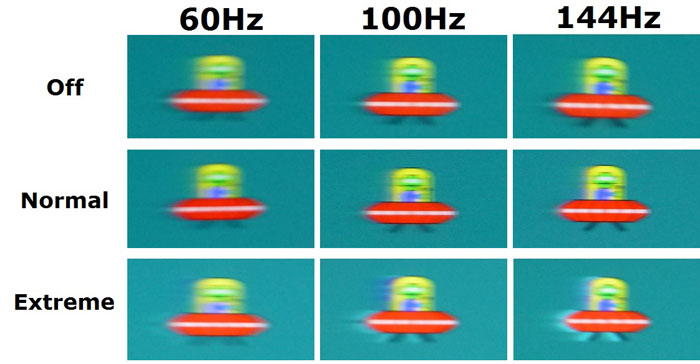
Note: ULMB
disabled
We carried out pursuit camera tests under each of
the three OD (overdrive) settings, and at 3 different refresh rates between 60Hz
and 144Hz. These tests can give you a good idea of actual perceived motion blur
in practice on the monitor. For now we left the ULMB mode turned off.


With OD turned off
there is a significant amount of motion blur perceived by the user when tracking
moving objects across the screen. The pixel response times come in to play here
as well as the refresh rate. With OD off the response times were pretty slow
with an ~11ms G2G average recorded with our oscilloscope. This remained the same
regardless of the refresh rate when OD was turned off. This slow response time
manifests itself with a significant motion blur in practice. Switching from 60Hz
up to 100Hz and then 144Hz brings about some changes in blurring, where it is
reduced at higher refresh rates as a direct result of the improved frame rate.
With response times remaining consistent with OD turned off, the reduction in
motion blur perceived is down to the refresh rate entirely. The moving image
becomes clearer and easier to track with the eyes as you increase screen refresh
rate.

Switching the OD
setting up to the optimal 'normal' mode, there are noticeable improvements in
response times (measured earlier) and in resulting motion blur. In fact with OD
at normal, the response times improve as you increase the refresh rate, from
8.7ms down to 5.9ms as you progress from 60Hz up to 144Hz refresh rate. We have
seen from our earlier tests that the refresh rate seems to impact the level of
overdrive applied to the liquid crystals, and so a higher refresh rate results
in lower response times. You are getting a double whammy here when it comes to
motion blur, with both the improved response times and higher frame rates having
a positive influence on the blurring that you see. At all refresh rates there is
a marked improvement in blur compared with OD off, as you would expect. It is
not eliminated entirely due to the nature of the sample-and-hold LCD display and
the tracking of your eyes.
No matter how fast the refresh rate and pixel
response times are, you cannot eliminate the perceived motion blur without other
methods (which is where ULMB comes in).

Blurring test,
OD normal, 60Hz
It is interesting
to note that with OD set to normal at 60Hz we measured an 8.7ms G2G response
time with no overshoot on the XB270HU. This would be considered a good result
for an IPS-type panel at 60Hz and on par with some of the best IPS models we've
seen in recent times (e.g. Dell U2415, 8.6ms G2G). Given response times are
comparable, the results obtained at 60Hz here are a decent representation of the
perceived motion blur you can expect from a normal 60Hz only IPS panel with good
response times around the 8.7ms G2G mark and with no overshoot. This is the
first IPS screen which can then offer higher refresh rates above 60Hz and the
added bonus of improved response times (without overshoot problems) as well.

With OD set to the
maximum 'extreme' setting there is again an improvement in blurring as you
increase the refresh rate. We had measured response times to range from 7.0 to
4.8ms G2G average as you increase refresh rate up, but at the same time we know
that the overshoot introduced becomes progressively worse. At 60Hz refresh rate
there are some signs of pale trailing compared with the OD normal mode. By the
time you reach up to the maximum 144Hz refresh rate the overshoot has become
very noticeable and extremely high. Remember also that these UFO tests are only
testing a few sample colour transitions, but we had measured some further very
significant overshoot across many different G2G changes with OD set to extreme.
We will reiterate that OD normal is optimum on this screen.

85Hz
100Hz
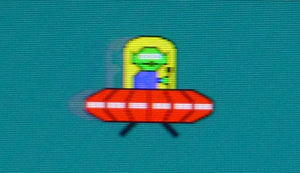

ULMB Enabled (PW = 100)
We left the strobe
pulse width length at maximum setting here as it has an impact on brightness if
you lower it, in an attempt to reduce motion blur even further. We felt the
results were very good without needing to reduce the strobe length anyway here.
With ULMB enabled the backlight is strobed briefly, once per refresh, for low
persistence. The brief backlight flash prevents tracking-based motion blur
and the moving object is far easier to see when tracking it across the screen
with your eyes (or by the pursuit camera). There is extremely little leftover
ghosting caused by pixel transitions (virtually invisible to the human eye),
since nearly all (>99%+) pixel transitions, including overdrive artefacts, are
now kept unseen by the human eye, while the backlight is turned off between
refreshes.
The clarity of the moving image is improved
significantly and tracking across the screen with your eye is much easier and
clearer. You will note there is some cross talk evident here in the form of the
trailing image, and a result of the strobe timing. These images were taken at
the centre of the screen vertically, so it gives you a good indication also of
the strobe cross-talk levels on this display, in the central region. In the
middle region of the screen it is at low/moderate levels but is not too
bothersome in practice. The cross-talk is reduced as you increase the refresh
rate as well which is pleasing. These tests give you a good visual indication of
the improvements which ULMB can bring in perceived motion blur.

Acer XB270HU vs. Asus ROG Swift PG278Q Pursuit Camera Comparisons


To make this really interesting, we brought the
excellent
Asus ROG Swift PG278Q back in to our lab as a reference point to make some
direct comparisons in these new tests.
We have also updated that review with full pursuit camera tests in
this relevant section.
We know from our review that if we leave the screen at the optimum OD normal
mode it maintains a very low response time across
all transitions (2.9ms G2G average), and that this is not controlled or impacted
by the refresh rate of the screen. So from 60Hz to 144Hz you are getting
consistently low response times of ~2.9ms G2G on the Asus screen. It will be interesting to compare this
further with the Acer XB270HU, which at the same optimum OD normal setting has response times varying between 8.7 and 5.9ms
G2G depending on the refresh rate (60 - 144Hz).
All tests were conducted at the optimum
'Normal' Overdrive setting on both screens. See the PG278Q review for further
tests at other settings.
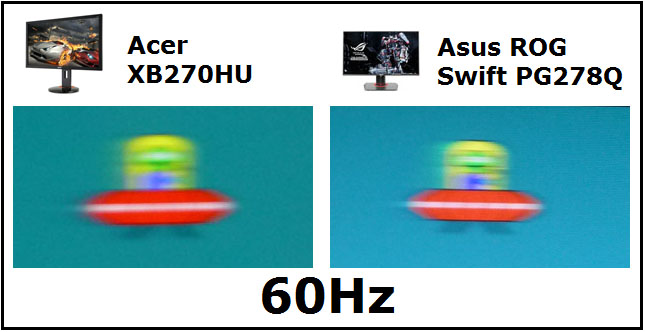
At 60Hz each refresh is displayed continuously
for a full 1/60 second (16.7ms). There is a significant amount of motion blur
perceived by the user when tracking moving objects across the screen on both
monitors. The clarity of the moving image on the Asus was a bit better here at
60Hz as the pursuit camera images reveal. This can be attributed to the larger
difference in response times between the two panels when running at 60Hz refresh
rate (2.9ms Asus vs. 8.7ms Acer). You can also compare the blur with the Asus VG278H at
60Hz (2ms G2G quoted response time) in the tests carried out by
BlurBusters.
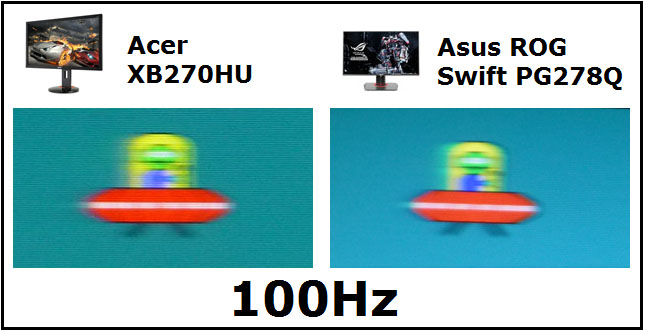
At 100Hz refresh
rate each refresh is displayed continuously for a full 1/100 second (10ms). This
creates less motion blur compared with 60Hz to the user because of the increased refresh rate, but
it it still there. There are improvements compared with 60Hz which right away
shows why a higher refresh rate has a positive impact on real-life blurring in
dynamic content. Until now, IPS-type panels have not been able to offer this
natively.
Again
the blurring is a
little less noticeable on the Asus here behind the red moving UFO, but you will
notice a more apparent bright trail behind the yellow portion of the image. On
the Asus this is where some of the overshoot becomes apparent, to a small
degree, on certain colour transitions. The Acer is free of overshoot artefacts
completely using the OD normal setting.
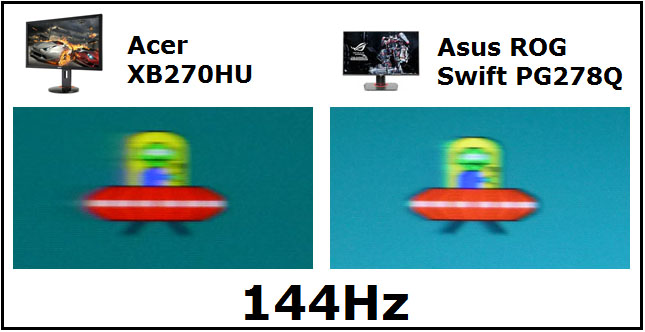
At 144Hz refresh
rate each refresh is
displayed continuously for a full 1/144 second (6.94ms). This creates less
motion blur still compared with before, but it is not eliminated entirely due to the sample and hold operation
of LCD displays and the tracking of your eyes. No matter how fast the refresh
rate and pixel response times are, you cannot eliminate the perceived motion
blur without other methods (which is where ULMB comes in). The response times of
the Acer have improved thanks to the increased refresh rate (5.9ms Acer vs.
2.9ms Asus). Again you will spot a
little more blur on the Acer behind the red part of the image, but a brighter
trail behind the yellow part on the Asus due to the overshoot which sometimes
manifests itself.
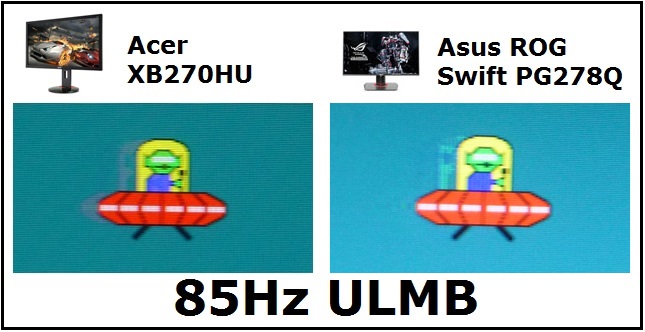
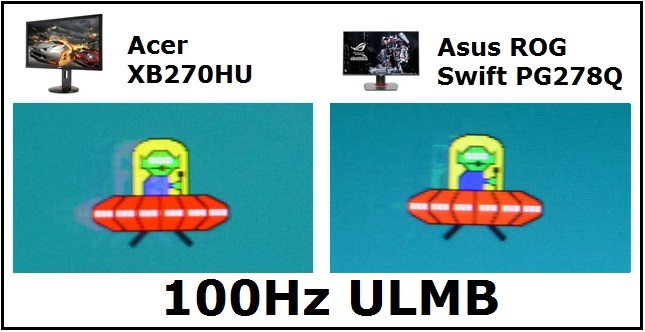
With ULMB enabled the backlight is
strobed briefly, once per refresh, for low persistence. The brief backlight
flash prevents tracking-based motion blur and the moving object is far easier to
see when tracking it across the screen with your eyes (or by the pursuit camera). There is extremely little leftover ghosting caused by pixel transitions
(virtually invisible to the human eye), since nearly all (>99%+) pixel
transitions, including overdrive artefacts, are now kept unseen by the human
eye, while the backlight is turned off between refreshes.
You will note there is
some cross talk evident here in the form of the trailing image on both screens, and a result of
the strobe timing. These images were taken at the centre of the screen
vertically, so it gives you a good indication also of the strobe cross-talk
levels on this display, in the central region. At the top of the screen there is
no cross talk visible, and at the bottom it is more pronounced. In the middle
region it is at low/moderate levels but is not too bothersome in practice. Again
you can see the effects of some overshoot on the Asus screen with a bright halo
behind the moving image being apparent. This is the trade-off for a little less
crosstalk though as the Acer seems to have a slightly more pronounced ghost image in the
central region of the screen due to the strobe timing. The Asus screen can also
be used at 120Hz with ULMB which brings about some further improvements in
motion clarity (see
this image). All in all, when using ULMB you are unlikely to spot any real
difference between the two screens unless you were running them side by side and
looking incredibly closely.
Update 2/9/15: later versions of the XB270HU now
feature support for 120Hz ULMB as well

Additional Gaming Features
-
Aspect Ratio Control -
The XB270HU does not offer any
aspect ratio control options through the OSD menu at all. This is due to a
limitation of using NVIDIA's new G-sync technology. As we understand it, it is
locked to only one defined resolution, in this case 2560 x 1440 so it is not
possible (or easy) to provide G-sync support with a scaler. This isn't really a
problem for PC use since you can just control the aspect ratio through your
graphics card settings. It would be an issue perhaps for external devices, but
since the XB270HU only has one input, you probably aren't going to be using this
screen for anything else anyway (consoles, DVD players etc). It's firmly aimed
at PC gaming use, so the absence of a scaler is not a big issue
here. The native 16:9 aspect ratio is of course beneficial since a lot of
content is in this aspect ratio anyway.
-
Preset Modes -
There are no specific gaming preset modes
available in the OSD. You may find some of the eColor modes useful perhaps if
you can find one with a preset brightness level you like for gaming. You can
change the gamma
setting in the menu as well for each preset, so you may want to set one of
them up with a different gamma level for your needs. There's actually even a
'gaming' gamma option in that menu, which results in a gamma of 3.0 average.

Lag
We have written an in depth article about
input lag and the various measurement techniques which are used to evaluate
this aspect of a display. It's important to first of all understand the
different methods available and also what this lag means to you as an end-user.
Input Lag vs. Display Lag vs. Signal
Processing
To avoid confusion with different terminology we
will refer to this section of our reviews as just "lag" from now on, as there
are a few different aspects to consider, and different interpretations of the
term "input lag". We will consider the following points here as much as
possible. The overall "display lag" is the first, that being the delay between
the image being shown on the TFT display and that being shown on a CRT. This is
what many people will know as input lag and originally was the measure made to
explain why the image is a little behind when using a CRT. The older stopwatch
based methods were the common way to measure this in the past, but through
advanced studies have been shown to be quite inaccurate. As a result, more
advanced tools like SMTT provide a method to measure that delay between a TFT
and CRT while removing the inaccuracies of older stopwatch methods.
In reality that lag / delay is caused by a
combination of two things - the signal processing delay caused by the TFT
electronics / scaler, and the response time of the pixels themselves. Most
"input lag" measurements over the years have always been based on the overall
display lag (signal processing + response time) and indeed the SMTT tool is
based on this visual difference between a CRT and TFT and so measures the
overall display lag. In practice the signal processing is the element which
gives the feel of lag to the user, and the response time of course can
impact blurring, and overall image quality in moving scenes. As people become
more aware of lag as a possible issue, we are of course keen to try and
understand the split between the two as much as possible to give a complete
picture.
The signal processing element within that is quite
hard to identify without extremely high end equipment and very complicated
methods. In fact the studies by Thomas Thiemann which really kicked this whole
thing off were based on equipment worth >100,1000 Euro, requiring extremely high
bandwidths and very complicated methods to trigger the correct behaviour and
accurately measure the signal processing on its own. Other techniques which are
being used since are not conducted by Thomas (he is a freelance writer) or based
on this equipment or technique, and may also be subject to other errors or
inaccuracies based on our conversations with him since. It's very hard as a
result to produce a technique which will measure just the signal processing on
its own unfortunately. Many measurement techniques are also not explained and so
it is important to try and get a picture from various sources if possible to
make an informed judgement about a display overall.
For our tests we will continue to use the SMTT
tool to measure the overall "display lag". From there we can use our
oscilloscope system to measure the response time across a wide range of grey to
grey (G2G) transitions as recorded in our
response time
tests. Since SMTT will not include the full response time within its
measurements, after speaking with Thomas further about the situation we will
subtract half of the average G2G response time from the total display lag. This should allow us to give a good estimation of
how much of the overall lag is attributable to the signal processing element on
its own.
Lag Classification
To help in this section we will also introduce a broader classification system
for these results to help categorise each screen as one of the following levels:
-
Class 1)
Less than 16ms / 1 frame lag - should be fine for gamers, even at high levels
-
Class
2)
A lag of 16 -
32ms / One to two frames - moderate lag but should be fine for many gamers.
Caution advised for serious gaming and FPS
-
Class
3)
A lag of more
than 32ms / more than 2 frames - Some noticeable lag in daily usage, not
suitable for high end gaming
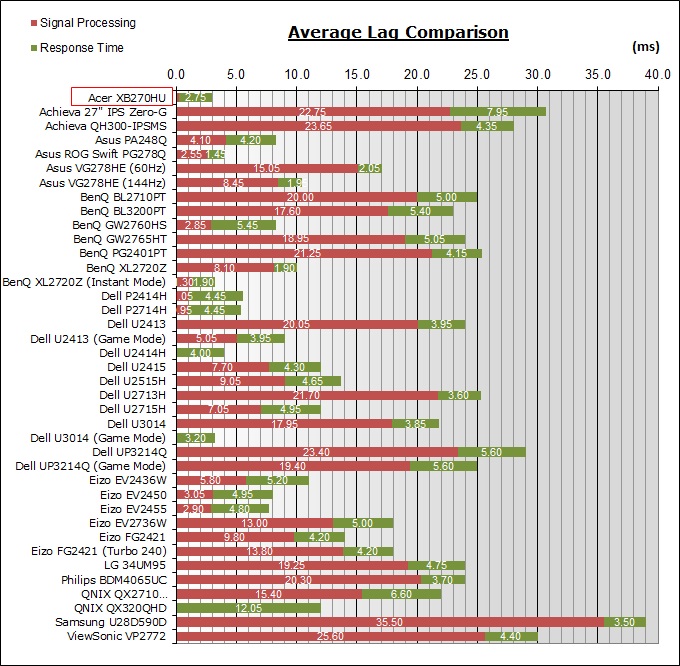
For the full reviews of the models compared here and the dates they were written
(and when screens were approximately released to the market), please see our
full
reviews index.
|
(Measurements in ms) |
|
|
Total Display Lag (SMTT
2) |
3.00 |
|
Pixel Response Time
Element |
2.75 |
|
Estimated Signal
Processing Lag |
0.25 |
|
Lag Classification |
1 |
|

Class
1 |
We have provided a comparison above against other
models we have tested to give an indication between screens. The screens
tested are split into two measurements which are
based on our overall display lag tests (using SMTT) and half the average G2G
response time, as measured by the oscilloscope. The response time is split from
the overall display lag and shown on the graph as the green bar. From there, the
signal processing (red bar) can be provided as a good estimation.
The screen showed a total average display lag of
only 3.00 ms as measured with SMTT 2. Taking into account half the average G2G
response time at 2.75ms ('Normal' OD setting), we can estimate that
there is ~0.25 ms of signal
processing lag on this screen, basically nothing. This makes the screen very
suitable for gaming, even playing fast FPS games. We tested the lag at various
refresh rates between 60 and 144Hz and it remained constant. Turning on ULMB
didn't add any additional lag either. G-sync seemed to add a very minor amount
of lag, a few milliseconds at most and nothing to worry about at all.

Gaming Summary
The overall gaming performance of the Acer XB270HU
was honestly pretty amazing, beyond what we were expecting really. This screen is obviously aimed
completely at gaming, and it won't disappoint. First of all you have the large
2560 x 1440 resolution which has been around for many years in this size format.
This of course provides a huge boost in resolution, image quality and detail
compared with the wide range of 1080p models. However, with the exception of the
Asus ROG Swift PG278Q (and ignoring the overclockable Korean models) the 1440p
models have all been limited until now to 60Hz refresh rate. This is the World's
first 144Hz compatible IPS-type panel. You get the benefits of IPS technology
including wide viewing angles and stable image appearance, combined with the
high refresh rate, and frame rate support normally reserved for TN Film panels.
The support for refresh rates up to 144Hz is obviously a huge benefit, providing
smooth, fast and fluid movement and the ability to produce high frame rates for
competitive gaming. As an additional note, you also get a lighter AG coating on
this AHVA panel than on TN Film matrices.
Response times were very impressive and fast, and
beyond what we expected from an IPS-type panel. We were expecting response times
to be around the 8.6ms mark at best, which is what we'd experienced fairly
consistently from other modern IPS panels. The refresh rate dynamically affects
the overdrive control on this model, so response times reach down to 5.5ms G2G
by the time you reach 144Hz. Best of all, if you stick to the 'normal' OD mode,
all this is achievable without introducing any overshoot. The fastest TN Film
models like the Asus ROG Swift PG278Q might have had slightly faster pixel
transitions by a few ms, but their overshoot was at moderate levels. We actually
preferred the artefact-free fluidity of the panel here and response times were
low enough to be able to cope with the high frame rates offered. That's been the
problem with overclockable Korean models, leading to common issues with ghosting
and blurring even though you get a more fluid feel to the screen thanks to the
overclocked refresh rate. Here, the pixel response times are very good so
combined with the high refresh rate, it's a great gaming experience. As we've
already mentioned, you also get the added benefits of the image quality offered
from the IPS-type panel as compared with TN Film models.
When you consider that Acer have then provided
NVIDIA's new G-sync dynamic refresh rate technology AND a blur reduction
backlight, you really do have a monster of a gaming screen on your hands. The
only thing missing is NVIDIA 3D Vision support, but that seems to have become
less of a focus of late for most manufacturers. G-sync works extremely well,
overcoming many of the problems associated with older Vsync usage. It certainly
is one of the biggest upgrades in a long time when it comes to gaming and
displays. The ULMB backlight worked very well also, offering noticeable and
marked improvements in image quality and reduced motion blur when tracking
movement across the screen. It was pretty well implemented and even offered a
useful control over the strobe length for those who like to tweak things a bit.
There was low levels of strobe cross-talk in the central regions of the screen,
and some users might have liked to have controlled the strobe phase (timing)
themselves, but for the majority of users it won't matter at all. It is also
limited to only working at 85Hz and 100Hz refresh rates, although as we've said
earlier there are reasons for the lack of support at 120Hz+.
Update 2/9/15: later versions of the XB270HU now
feature support for 120Hz ULMB as well
There are obvious and noticeable benefits when it
comes to perceived blur reduction which is the main thing and running a screen
like this at 100Hz is a joy with blur reduction applied as well. This is the
first time we've seen a blur reduction mode on an IPS-type panel, and it worked
nicely. It should be noted also that it has minimal impact on the colour and
appearance of the screen, although you do of course lose some brightness range.
The lag of the display was basically non-existent which was excellent news.
There are a few slight issues we will address here
as well. The graphics card support needs to be taken into consideration, and you
will probably have to have a high end GPU and system to really benefit from
everything this screen can offer. Given the screen's comparatively high price tag,
we expect most buyers will already be equipped with the system they need. It would
have been nice to see some more customisable preset modes available from the screen so you didn't
have to manually adjust things between gaming and regular uses. It's missing
some of the "extras" and bells and whistles that you might find from other
dedicated gaming screens, but the XB270HU is purely focused on power and
performance!
Move over Asus ROG Swift PG278Q, in our opinion
we've got a new king of gaming monitors!

Movies and Video

The following summarises the screens performance
in video applications:
-
27"
screen size makes it a reasonable option for an all-in-one multimedia screen,
much smaller than LCD TV's and many larger format desktop monitors which are
now emerging.
-
16:9
aspect ratio is well suited to videos and movies, leaving
you with smaller/no borders on DVD's and wide screen content at the top and
bottom than on a 16:10 aspect display.
-
2560 x
1440 resolution can support full 1080 HD resolution content.
-
Digital DisplayPort interface support HDCP for any encrypted and protected content
-
Only DisplayPort connections available on
its own. If you're watching movies from your PC that isn't a problem, but you
don't have the option to connect additional external devices here. Interface
limitations are related to the support of G-sync and the nature of this panel.
-
Cables provided in the box
for DisplayPort.
-
Light
AG coating provides clear images with no major graininess, and without the
unwanted reflections of a glossy solution.
-
Wide
brightness range adjustment possible from the display, including high maximum
luminance of ~327
cd/m2 and a good minimum luminance of
53 cd/m2. This should afford you very good control for different
lighting conditions. Contrast ratio remains stable across most of that adjustment
range as well and is excellent for an IPS-type panel. Brightness regulation is controlled
without the need for PWM and so is flicker free at all settings which is
pleasing.
-
Black
depth and contrast ratio are very good for an IPS-type panel at 1000:1 after
calibration. Detail in darker scenes should not be lost as a result.
-
There
is a specific 'movie' eColor preset mode available for movies or video in the OSD
which is a bit cooler and more blue than our calibrated custom mode. It also
has a locked brightness setting. May be ok if you find the brightness level
suitable, if not you will probably be better adjusting the brightness in your
calibrated user mode yourself.
-
Very
good pixel responsiveness which can handle fast moving scenes in movies
without issue. No overshoot issues when sticking to the 'normal' response time
mode which is great news.
-
Although it has 120Hz+
refresh rate support it does not support NVIDIA 3D Vision.
-
Wide viewing angles from IPS panel technology
meaning several people could view the screen at once comfortable and from a
whole host of different angles. White glow from an angle on black content may
be problematic to some users and is common for IPS panel technology.
-
No
real backlight leakage on our sample which is good.
-
Wide range of ergonomic adjustments available
from the stand, allowing you to adjust the screen to suit varying viewing
positions.
-
No integrated stereo speakers offered on this model or audio connections.
-
No
hardware aspect ratio options on this screen, but given the lack of additional
inputs, your graphics card should be able to handle the scaling for you anyway
if needed.
-
Picture By Picture (PbP) or Picture In Picture (PiP) are not available on
this model.

Conclusion
We know how excited people were to get a
detailed review of this monitor as quickly as possible, so we decided to release
this as a full review straight away without making it a paid preview first. We
worked overtime to bring you this quickly as well so if you appreciate the early
access to the review and enjoy reading and like our work, we would welcome a
donation
to the site to help us continue to make quality and detailed reviews for you.
Move over Asus ROG Swift PG278Q, in our opinion
we've got a new king of gaming monitors! We won't repeat everything we've
been through in the gaming sections of this review but when you combine the high
2560 x 1440 resolution, fast response times, freedom from overshoot, 144Hz
refresh rate support, ULMB blur reduction mode, G-sync support and very low lag
you have one hell of a gaming monitor. We feel that this screen pips the
excellent Asus ROG Swift PG278Q thanks to its IPS panel, bringing with it a
lighter, clearer AG coating and improvements in image quality and viewing angles
compared with TN Film offerings. You're really combining the best of both worlds here. The Asus does have the edge we felt in appearance, design and build
quality but this XB270HU is a marked improvement over older office-line Acer
screens you might have seen in the past. Acer seem to be making a big effort to
enhance their monitor line-up and that's always a welcome thing.
In other areas the IPS-type panel provided good
all round performance. The default setup was a little off but could be corrected
fairly well even with some basic OSD adjustments. We would have liked to have
seen more customisable preset modes as they are a bit restrictive when it comes
to the locked brightness levels. The light AG coating and flicker free backlight
were very welcome, and the contrast ratio was strong for this panel technology
also. There was only a single DisplayPort connection offered because of the
current restrictions of using a G-sync module, so it is limited for those who
might want to connect external devices and for some graphics cards. The stand
provides a good range of adjustments and the OSD is pretty decent as well.
The screen is expected to be available to buy
around mid-April from what we've been told and no doubt it will be extremely
popular.
|
Pros |
Cons |
|
Excellent gaming experience,
low response times and lag. Support for NVIDIA G-sync and ULMB blur
reduction mode |
Limited connectivity with
DisplayPort only |
|
IPS technology benefits in a
gaming screen |
Lack of some bells and
whistles and customisable preset modes |
|
Flicker free backlight and
light AG coating |
Missing NVIDIA 3D Vision
support despite refresh rate |
|
Check Pricing and Buy - Direct Links
|
|
Amazon USA |
Amazon UK |
Overclockers UK |
Amazon GER |
Amazon CAN
|
|
TFTCentral is a participant
in the Amazon Services LLC Associates Programme, an affiliate
advertising programme designed to provide a means for sites to earn
advertising fees by advertising and linking to Amazon.com, Amazon.co.uk,
Amazon.de, Amazon.ca and other Amazon stores worldwide. We also
participate in a similar scheme for Overclockers.co.uk. |
|

|
TFT Central Awards Explained
We have two award
classifications as part of our reviews. There's the top 'Recommended'
award, where a monitor is excellent and highly recommended by us. There is
also an 'Approved' award for a very good screen which may not be perfect,
but is still a very good display. These awards won't be given out every
time, but look out for the logo at the bottom of the conclusion. A list of
monitors which have won our awards is available
here. |
|